- Second Opinion
A Child's First Dental Visit Fact Sheet
When should your child first see a dentist? You can take your child at a younger age, but experts recommend taking him or her within 6 months of the first tooth coming in (erupting), or by about 12 months at the latest.
At this time, the dentist can give you information on:
Baby bottle tooth decay
Infant feeding practices
Mouth cleaning
Pacifier habits
Finger-sucking habits

Prepare your child
If possible, schedule morning appointments so young children are alert and fresh.
Prepare a preschooler or older child for the visit by giving him or her a general idea of what to expect. Explain why it is important to go to the dentist. Build excitement and understanding.
Prepare yourself
Discuss your questions and concerns with the dentist. Remember that your feeling toward dental visits can be quite different from your child's. Be honest with your view of the dentist. If you have dental anxieties, be careful not to relate those fears or dislikes to your child. Parents need to give moral support by staying calm while in the dental exam room. Children can pick up parents' anxieties and become anxious themselves.
Prepare the dentist
At the first visit, give the dentist your child's complete health history. For a restoration visit, such as getting a cavity filled, tell the dentist if your child tends to be stubborn, defiant, anxious, or fearful in other situations.
Watch how your child reacts. Many parents are able to guess how their child will respond and should tell the dentist. Certain behaviors may be linked to your child's age:
10 to 24 months. Some securely attached children may get upset when taken from their parents for an exam.
2 to 3 years. A securely attached child may be able to cope with a brief separation from parents. In a 2-year-old, "no" may be a common response.
3 years. Three-year-olds may not be OK being apart from a parent when having a dental procedure such as getting a cavity filled. This is because most 3-year-olds are not socially mature enough to separate from parents.
4 years. Most children should be able to sit in another room from parents for exams and treatment procedures.
The first visit
Your child's first dental visit is to help your child feel comfortable with the dentist. The first dental visit is recommended by 12 months of age, or within 6 months of the first tooth coming in. The first visit often lasts 30 to 45 minutes. Depending on your child's age, the visit may include a full exam of the teeth, jaws, bite, gums, and oral tissues to check growth and development. If needed, your child may also have a gentle cleaning. This includes polishing teeth and removing any plaque, tartar, and stains. The dentist may show you and your child proper home cleaning such as flossing, and advise you on the need for fluoride. Baby teeth fall out, so X-rays aren’t often done. But your child's dentist may recommend X-rays to diagnose decay, depending on your child's age. X-rays are also used to see if the root of a jammed baby tooth may be affecting an adult tooth. In general, it is best that young children not have dental X-rays unless absolutely needed.
The second visit
Just like adults, children should see the dentist every 6 months. Some dentists may schedule visits more often, such as every 3 months. This can build comfort and confidence in the child. More frequent visits can also help keep an eye on a development problem.
Protect your children's teeth at home
Here are some tips to protect your children's teeth:
Before teeth come in, clean gums with a clean, damp cloth.
Start brushing with a small, soft-bristled toothbrush and a very small amount of toothpaste (the size of a grain of rice) when your child's first tooth appears. Use a pea-sized dab of fluoridated toothpaste after 3 years of age. This is when the child is old enough to spit out the toothpaste after brushing.
Prevent baby bottle tooth decay. Don't give children a bottle of milk, juice, or sweetened liquid at bedtime or when put down to nap.
Limit the time your child has a bottle. Your child should empty a bottle in 5 to 6 minutes or less.
Help your child brush his or her own teeth until age 7 or 8. Have the child watch you brush, and follow the same brushing pattern to reduce missed spots.
Limit foods and treats that increase tooth decay. This includes hard or sticky candies, fruit leather, and sweetened drinks and juice. Offer fruit rather than juice. The fiber in fruit tends to scrape the teeth clean. Juice just exposes the teeth to sugar.
- Pediatric Cardiology
- Our Services
- Chiari Malformation Center at Stanford Medicine Children's Health
Related Topics
Dental Care for Infants and Children
Adolescent Problems of the Teeth and Mouth
Connect with us:
Download our App:
- Leadership Team
- Vision, Mission & Values
- The Stanford Advantage
- Government and Community Relations
- Get Involved
- Volunteer Services
- Auxiliaries & Affiliates
© 123 Stanford Medicine Children’s Health
When Should Baby Visit the Dentist for the First Time?
Medical review policy, latest update:, when to schedule baby's first dental visit, how to choose a dentist for your child, read this next, what happens at baby's first dentist visit, tips to make your child’s dentist visit easier, how often to visit the dentist.
Based on how your toddler’s teeth look, your dentist will let you know when to make the next visit. Most experts recommend that toddlers see the dentist about every six months — as long as there are no major problems. So don’t forget to schedule your child’s second appointment on your way out the door!
What to Expect the First Year , 3rd Edition, Heidi Murkoff. What to Expect the Second Year , Heidi Murkoff. WhatToExpect.com, Toddler Dental Care , March 2019. WhatToExpect.com, Is Your Toddler Teething? , April 2020. WhatToExpect.com, Preventing Cavities and Keeping Baby's Teeth Healthy , April 2020. WhatToExpect.com, Brushing Baby's Teeth , July 2020. American Academy of Pediatrics, Baby's First Tooth: 7 Facts Parents Should Know , November 2020. American Academy of Pediatrics, Good Oral Health Starts Early , November 2020 American Academy of Pediatric Dentistry, Frequently Asked Questions , 2021. American Dental Association, Taking Care of Your Child’s Smile , May 2014.
Go to Your Baby's Age
Trending on what to expect, the covid-19 vaccine for infants, toddlers and young children, how to create a night shift system when you have a newborn, ⚠️ you can't see this cool content because you have ad block enabled., when do babies start laughing, baby-led weaning, what happens in the ‘4th trimester’ (and is it a real thing).
- Find-a-Dentist
Your Baby's First Dental Visit
Your baby is hitting new milestones every day, and his or her first dental visit is another one to include in the baby book!
Your child’s first dental visit should take place after that first tooth appears , but no later than the first birthday. Why so early? As soon as your baby has teeth , he or she can get cavities. Being proactive about your child’s dental health today can help keep his or her smile healthy for life. (Need a dentist? Use our Find-A-Dentist tool to find one in your area.)
How to Prepare
Moms and dads can prepare, too. When making the appointment, it can’t hurt to ask for any necessary patient forms ahead of time. It may be quicker and easier for you to fill them out at home instead of at the office on the day of your visit.
Make a list of questions, as well. If your child is teething , sucking his or her thumb or using a pacifier too much, your dentist can offer some advice.
What to Expect During the Visit
If your child cries a little or wiggles during the exam, don’t worry. It’s normal, and your dental team understands this is a new experience for your child!
Tips for a Great Visit
- Don’t schedule an appointment during naptime. Instead, pick a time your child is usually well-rested and cooperative.
- Make sure your child has had a light meal and brushes their teeth before their appointment so they won’t be hungry during their visit.
- Save snacks for after the visit so they aren’t on your child’s teeth during the exam.
- Think of the appointment as a happy and fun experience. If your child becomes upset during the visit, work with your dentist to calm your child. You’re on the same team!
- Trying to Conceive
- Signs & Symptoms
- Pregnancy Tests
- Fertility Testing
- Fertility Treatment
- Weeks & Trimesters
- Staying Healthy
- Preparing for Baby
- Complications & Concerns
- Pregnancy Loss
- Breastfeeding
- School-Aged Kids
- Raising Kids
- Personal Stories
- Everyday Wellness
- Safety & First Aid
- Immunizations
- Food & Nutrition
- Active Play
- Pregnancy Products
- Nursery & Sleep Products
- Nursing & Feeding Products
- Clothing & Accessories
- Toys & Gifts
- Ovulation Calculator
- Pregnancy Due Date Calculator
- How to Talk About Postpartum Depression
- Editorial Process
- Meet Our Review Board
How to Prepare Your Child for Their First Dental Visit
Verywell / Madelyn Goodnight
What to Expect
Choosing a dentist.
- Getting Ready For The Visit
Preparing as a Parent
One of the most frequently asked questions I get as a Pediatric Dentist is, “When should I bring my baby in for their first dental visit?”
The Academy of Pediatric Dentistry recommends that a child should visit the dentist when the first tooth appears or no later than their first birthday. While it may sound early, starting at that age will start your baby on a path for great oral health and prevent a number of dental problems that can occur during childhood.
The first visit gives parents a chance to become educated on how to properly care for their child's teeth and gives children a chance to become comfortable with the dental environment at an early age.
At the first visit, the dentist will examine your baby's mouth to make sure everything is growing and developing properly and will check for dental caries, tongue ties, and any signs of injuries.
The dentist will typically tell you everything you need to know to keep your child's teeth healthy including:
- What kind of toothpaste and toothbrush to use
- Brushing and flossing techniques
- How to relieve teething discomfort
- Which foods and drinks cause cavities
- Answers to questions about pacifier use and thumb-sucking.
The examination and cleaning itself can take just a few minutes, but most of the time is spent on making the child feel comfortable and educating the parents. You should not expect the overall visit to take a long time.
The first step is finding a Pediatric Dentist for your child. Pediatric Dentists have two to three additional years of training after dental school during which they extensively study child development, behavior management of patients from infancy to adolescence, and how best to work with special needs children.
Most Pediatric Dentists will aim to provide a fun environment with toys, stickers, TVs, games, yummy flavored toothpaste, and staff that enjoy working with children. When children are having fun, they gain trust in the dentist and staff, and will often enjoy their visits and look forward to their next appointment.
Where to Find a Dentist
To find a Pediatric Dentist in your area, you can Google nearby pediatric dentists, talk to other parents you know for recommendations, and ask your child's pediatrician or your own dentist. If you have dental insurance, you can search for a Pediatric Dentist through your list of participating providers.
Getting Ready For Your Child's Visit
When you have decided on an office, call them to schedule a visit. Young children tend to do their best in the morning when they are fresh and full of energy. Avoid scheduling appointments late in the day or close to nap times when children can be groggy or cranky.
You can inquire if it is possible for you and your child to come to the office for a tour and to meet the doctor before the actual day of the checkup. If your child has any special needs, discuss it with the staff member that schedules your appointment. The dentist will often want a little extra time scheduled for this.
If there is something in particular that keeps your child calm and happy (a song they like to hear, a video they like to watch or simply a color they like), let the dentist know so they can try to incorporate that into the visit.
Mental Preparation
Once you have an appointment scheduled, start preparing your child for the visit. Children learn best when they are having fun. You can practice giving their stuffed animal a checkup with a toy mirror.
Your child can bring that same stuffed animal to the dental visit to get a check-up by the dentist. Read books to them. I recommend:
- Show Me Your Smile! A Visit to the Dentist (Dora the Explorer)
- Dentist Trip (Peppa Pig)
- Elmo Visits the Dentist by P.J. Shaw
You can also watch one of the many YouTube videos about going to the dentist, such as Daniel Tiger's .
Put Them At Ease
When talking to your child about their upcoming trip to the dentist, you can assure them that there are no shots at this visit and that the dentist will simply examine and brush their teeth and talk to them about how to keep their teeth healthy.
Let them know that the dentist will show them all of the tools and explain all of the procedures before starting. You can also plan a treat (not candy or junk food) such as a trip to the park or toy store should they need a little extra motivation.
Anticipating Follow Up Visits
Once you've completed your first visit, it's time to start preparing your child for their second visit! Discuss the visit with your child and remind them of the positive things that happened such as:
- There were no shots
- Nothing hurt
- The toothpaste tasted great
- The toothbrush tickled
- The dentist counted all of your teeth and now we know how many teeth you have
- You got prizes and a new toothbrush at the end
- Next time we go there, we'll get these fun prizes all over again!
To prepare yourself, come on time, if possible a few minutes earlier to fill out any registration and consent forms that may be needed. Many offices have their registration forms on their website so you can fill them out in advance.
Give your dentist a complete health history of your child. If your child is taking any medications, have a list of the medications and dosages. Have your child's pediatrician's contact information available.
If you have any particular questions that you want the dentist to address, write them down so you don't forget to ask them if the dentist doesn't bring those topics up.
It is also important to have reasonable expectations of your child. During the visit, some children may open their mouths willingly and enjoy the experience, while some will not, just as some do not enjoy getting haircuts or wearing seatbelts. Luckily, with preparation and sticking to a regular recall schedule (typically every six months), the visits will get easier and more enjoyable each time.
Many children that may start out fearful or anxious can become patients that love going to the dentist once they've been a few times.
By Rashmi Ambewadikar, DDS Rashmi Ambewadikar, DDS is a pediatric dentist practicing in Queens, New York and is the owner of Astoria Smiles Pediatric Dentistry.

- Walk-in Clinic Wait Times
Focus on Healthy Kids and Teens
- A Child's First Dental Visit Fact Sheet
When should your child first see a dentist? You can take your child at a younger age, but experts recommend taking your child within 6 months of the first tooth coming in (erupting), or by about 12 months at the latest.
At this time, the dentist can give you information on:
Baby bottle tooth decay
Infant feeding practices
Mouth cleaning
Pacifier habits
Finger-sucking habits
Prepare your child
If possible, schedule morning appointments so young children are alert and fresh.
Prepare a preschooler or older child for the visit by giving them a general idea of what to expect. You can tell them about the exam room, the instruments they might see, the face masks the dentist and hygienist may wear, and the bright exam light. Explain why it is important to go to the dentist. Build excitement and understanding.
Prepare yourself
Discuss your questions and concerns with the dentist. Remember that your feeling toward dental visits can be quite different from your child's. Be honest with your view of the dentist. If you have dental anxieties, be careful not to relate those fears or dislikes to your child. Parents need to give moral support by staying calm while in the dental exam room. Children can pick up parents' anxieties and become anxious themselves.
Prepare the dentist
If you don't know the dentist, interview the person first to see if they sound right for your child's needs and personality. At the first visit, give the dentist your child's complete health history. For a restoration visit, such as getting a cavity filled, tell the dentist if your child tends to be stubborn, defiant, anxious, or fearful in other situations. Ask the dentist how they handle such behavior. If you aren't comfortable with the answer, find another dentist.
Watch how your child reacts. Many parents are able to guess how their child will respond and should tell the dentist. Certain behaviors may be linked to your child's age:
10 to 24 months. Some securely attached children may get upset when taken from their parents for an exam.
2 to 3 years. A securely attached child may be able to cope with a brief separation from parents. In a 2-year-old, "no" may be a common response.
3 years. Three-year-olds may not be OK being apart from a parent when having a dental procedure, such as getting a cavity filled. This is because most 3-year-olds are not socially mature enough to separate from parents.
4 years. Most children should be able to sit in another room from parents for exams and treatment procedures.
The first visit
Your child's first dental visit is to help your child feel comfortable with the dentist. The first dental visit is recommended by 12 months of age, or within 6 months of the first tooth coming in. The first visit often lasts 30 to 45 minutes. Depending on your child's age, the visit may include a full exam of the teeth, jaws, bite, gums, and oral tissues to check growth and development. If needed, your child may also have a gentle cleaning. This includes polishing teeth and removing any plaque, tartar, and stains. The dentist may show you and your child correct home cleaning, such as flossing, and advise you on the need for fluoride. Baby teeth fall out, so X-rays aren’t often done. But your child's dentist may recommend X-rays to diagnose decay, depending on your child's age. X-rays are also used to see if the root of a jammed baby tooth may be affecting an adult tooth. In general, it is best that young children not have dental X-rays unless absolutely needed.
The second visit
Just like adults, children should see the dentist every 6 months. Some dentists may schedule visits more often, such as every 3 months. This can build comfort and confidence in the child. More frequent visits can also help keep an eye on a developmental problem. Talk to your dentist about payment options if the cost of dental care is a problem for you.
Protect your children's teeth at home
Here are some tips to protect your children's teeth:
Before teeth come in, clean gums with a clean, damp cloth.
Start brushing with a small, soft-bristled toothbrush and a very small amount of fluoride toothpaste (the size of a grain of rice) when your child's first tooth appears. Use a pea-sized dab of fluoridated toothpaste after 3 years of age. Children should spit after brushing. Encourage them not to swallow extra toothpaste.
Prevent baby bottle tooth decay. Only put breastmilk or formula in bottles. Don't give children a bottle of juice, soft drinks, or sweetened liquid.
Limit the time your child has a bottle. Children should finish bottles before going to sleep.
Encourage your child to use a cup around their first birthday.
Help your child brush their teeth until age 7 or 8. Have the child watch you brush and follow the same brushing pattern to reduce missed spots.
Limit foods and treats that increase tooth decay. This includes hard or sticky candies, fruit leather, and sweetened drinks and juice. Offer fruit rather than juice. The fiber in fruit tends to scrape the teeth clean. Juice just exposes the teeth to sugar.
Related Items
Diseases and conditions.
- Dental Care for Infants and Children
Pediatric Diseases and Conditions
- Adolescent Problems of the Teeth and Mouth
- Common Dental Problems and Concerns
- Infant Problems of the Teeth and Mouth
- Preschool and School-Aged Problems of the Teeth and Mouth
- Toddler Problems of the Teeth and Mouth
- Health Screening Guidelines for Children from Birth to Age 2
- Health Screening Guidelines, Ages 2 to 18
Skip Navigation
Oral Health

Whitening Products
Whitening Solutions
- All Optic White® products
- Pro Series Toothpaste
- ComfortFit LED Device
- Overnight Teeth Whitening Pen
- Express Teeth Whitening Pen
- Renewal Toothpaste
- Advanced Toothpaste
- Stain Fighter® Toothpaste
- Charcoal Toothpaste
- Whitening Mouthwash
- Adult Orthodontics (Braces)
- Bad Breath (Halitosis)
- Bridges & Crowns
- Brushing & Flossing
- Cleft Lip /Palate
- Cracked Tooth Syndrome
- Dental Emergencies & Sports Safety
- Dental Health Threats
- Dental Product Guidance
- Dental Sealants
- Dental Visits
- Developmental Conditions
- Diabetes & Endocrine Disorders
- Digestive (Gastrointestinal) Disorders
- Early Orthodontics (Braces)
- Gum Disease (Gingivitis)
- Heart Disease
- HIV/AIDS & STDS
- Immune Disorders
- Jaw Pain (TMD)
- Mouth & Teeth Anatomy
- Mouth Sores & Infections
- Nutrition & Oral Health
- Oral Cancers
- Oral Care: Babies (0-4)
- Oral Care: Kids (5-12)
- Oral Care: Teens (13-17)
- Oral Care: Adults (18+)
- Oral Care: Adults (55+)
- Pain Management (Anesthesia)
- Plaque & Tartar
- Pregnancy Oral Care
- Respiratory Conditions
- Root Canals
- Special Occasions
- Teeth Bonding
- Teeth Grinding (Bruxism)
- Teeth Whitening
- Tooth Extraction
- Tooth Fairy
- Tooth Sensitivity
- Wisdom Teeth
- View All Article Categories >
- Toothpastes
- Toothbrushes
- Mouthwashes & Rinses
- Prescription Products
- Specialty Products
- Teeth Whitening Products
- Colgate ® Total
- Colgate ® 360º
- Colgate ® MaxFresh ®
- Colgate ® with Charcoal
- Colgate ® Enamel Health ™
- Colgate ® Optic White ®
- Colgate ® Kids
- Colgate ® Sensitive
- Colgate ® Keep
- Colgate ® Renewal
- Colgate ® Hum
- View all products >
- Our Mission
- About our Mission
- Smile First
- Accessible Oral Care
- Innovation Champions
- Bright Smiles, Bright Futures
- About the Program
- Art Contest
- Classroom Kit & Samples
- Material and Resources
- Mobile Dental Vans
- Sustainability
- About Sustainability
- Recyclable Tube
- Sustainable Products
- Sustainable Habits
- Haz La U Grants
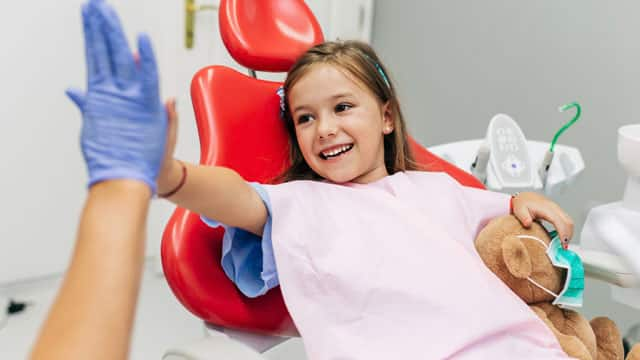
How to Prepare for Your Child's First Dental Visit
Top articles, more articles.
Medically Reviewed By Colgate Global Scientific Communications
Whether your baby's first tooth popped up this week or your toddler's finally ready to sit still for the dentist, you made your child's first dental appointment. Hooray! The American Dental Association (ADA) recommends scheduling a dental visit as soon as the child's first tooth appears. Still, it's never too late to take your kid to see the dentist. After you've completed the hard work of finding a kid-friendly dentist , you might wonder how to best prepare for your child's first dental visit. Check out these three simple steps and learn what you can expect once your kid's in the dental chair.
Step 1: Schedule the Dental Appointment
Try to schedule your child's first dentist appointment when they will be the least fussy, and make sure they are well-rested and fed before you arrive. While making the appointment, you can also ask about completing health history forms in advance and if the office will need any additional information to help limit the time waiting in the office. A quick call to your dental insurance provider can also confirm your coverage and determine if there will be any additional copays.
Step 2: Prepare for the Dental Appointment
A child's first dental visit should not be a surprise. Take some time to talk to your child about what will happen at the appointment. You can also read books or watch a television show about a friendly dental visit to help them visualize what it will be like. If your child is older, you can make a pretend trip to the dentist and practice opening their mouth wide to count their teeth. For more ambitious parents, the internet provides a variety of crafts to teach your children the importance of taking care of your teeth. Parents can also prepare for a child's first visit by completing any paperwork, writing down the child's medications, and making a list of any questions.
Step 3: Make the Dental Appointment Fun
Keeping a positive attitude and talking excitedly about the dental visit will go a long way in making your child feel comfortable instead of scared. However, if you sense your child is nervous, bring along a stuffed animal friend. The "friend" — or an older sibling — can go first, and the dental professional can demonstrate what will happen next or answer any of the child's questions. If your child still has dental anxiety , there are many things you can do to make them feel safe. Many dentists will provide a reward at the end of the appointment, but you may also want to pack a treat. Stickers, a new toothbrush, or a small toy all make great rewards.
What to Expect at Your Baby's First Dental Appointment
Depending on how comfortable — or wiggly — your child is, they may sit directly in the chair or in your lap. The dentist will check their jaw, teeth, and gums for proper development, cavities, or other issues. Either the dentist or dental hygienist will clean the child's teeth and provide education on how to properly take care of your child's teeth and gums. At the end of the appointment, the dentist can answer any questions you may have — from pacifier use to the best nutrition for healthy teeth.
Setting a positive precedent for dental appointments at an early age can help children create lifelong oral hygiene habits. By following these steps and taking the time to prepare for your child's first dental visit, you can help your child enjoy the dentist and look forward to future appointments.
Oral Care Center articles are reviewed by an oral health medical professional. This information is for educational purposes only. This content is not intended to be a substitute for professional medical advice, diagnosis or treatment. Always seek the advice of your dentist, physician or other qualified healthcare provider.

Want more tips and offers sent directly to your inbox?
Sign up now
Recommended Products

Thank you for submitting your feedback!
If you’d like a response, Contact Us .

You also might like

Sign up now ">
Social Impact
Where to Buy
United States (US English)
ColgateProfessional.com
Shop.Colgate.com
Submit an Idea

© YYYY Colgate-Palmolive Company. All rights reserved.
Terms Of Use
Privacy Policy
All Products
About Our Ads
Children's Privacy Policy
All Articles
Cookie Consent Tool
Do Not Sell My Personal Information
All Educational Resources
- Shop for insurance
- Find a dentist
When should your child first visit the dentist?
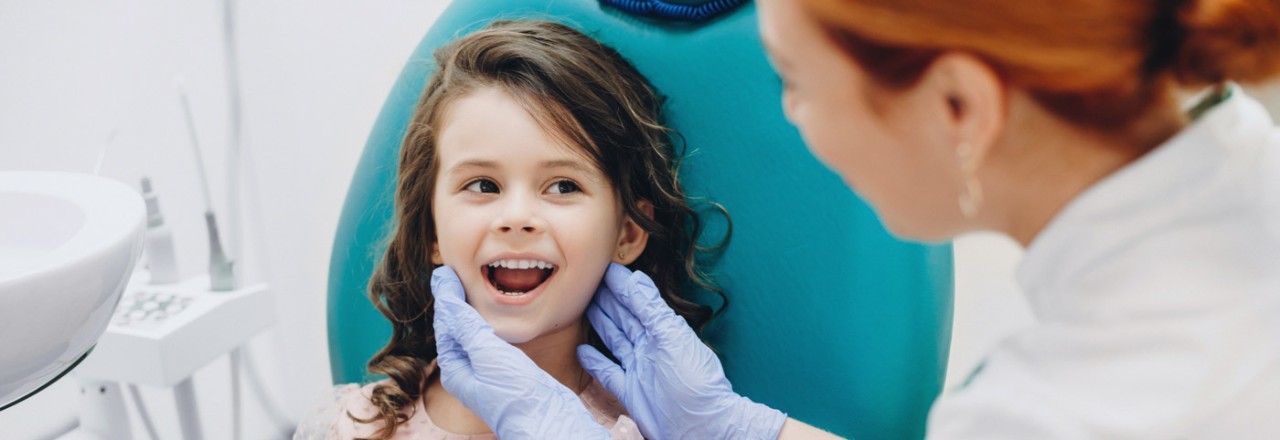
Most American children see their family dentist for the first time well after their second birthday, far later than recommended by dental professionals.
The American Academy of Pediatric Dentistry (AAPD) recommends that children visit the dentist for the first time by age 1, or within six months of the date their first tooth erupts. Primary teeth typically begin growing in around 6 months of age.
Why caring for baby teeth is important
According to the AAPD, primary (or “baby”) teeth in should stay in place until they’re lost naturally. This is because these teeth serve several important purposes:
- They help children chew properly.
- They’re involved in speech development.
- They save space for permanent teeth.
- A healthy smile helps children feel good about how they look.
Preparing for your child’s first dentist visit
If you begin taking your children to the dentist around the time the first tooth erupts, then they’re probably too young to be nervous. But if you wait until your children are older than 2 years old to take them to the dentist for the first time, they may feel anxious about their visit.
What’s the best way to prepare your child for the whirring machinery and sharp instruments, and the strangers who will be examining his or her teeth?
- Give your child a sneak preview . Take your child to your next dental checkup so he or she can watch you have your teeth examined and cleaned.
- Learn more about it . You can find books and online resources to teach children more about dental health and dentist visits. Try a classic children’s book about going to the dentist for the first time, such as Curious George Visits the Dentist .
- Play dentist . Take turns being the dentist and the patient with your child. Examine each other’s teeth with a mirror, or use your fingers to count each other’s teeth so that your child will be familiar with the feel of a dentist examination.
- Timing is everything . Plan plenty of time so that the dental visit isn’t rushed, and make sure your child is well-rested before the visit so that he or she feels relaxed and comfortable.
Last updated Febrary 3, 2022
Related articles:
An oral health guide for your growing child.
Every stage in a child's life comes with different dental needs and responsibilities. Do your part to make sure your child’s oral health care is on track from the start.
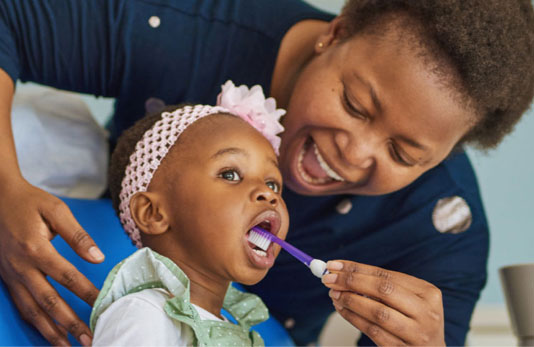
Make brushing fun for kids
Having trouble getting your little one to brush their teeth? If you feel challenged, here are some tips.
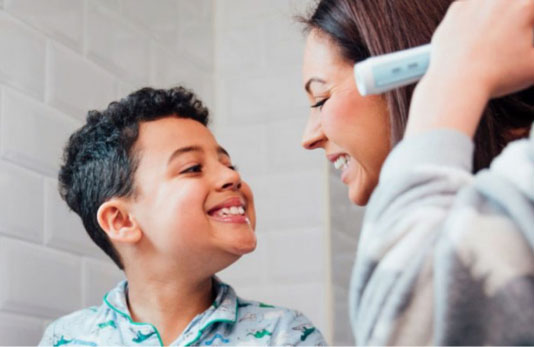
Make over your grocery list
Give your fridge and pantry a makeover with these mouth-friendly shopping tips. Here’s what to keep and what to toss.

The oral health information on this website is intended for educational purposes only. Always consult a licensed dentist or other qualified health care professional for any questions concerning your oral health.
From the First Tooth
Resources for parents & caregivers.
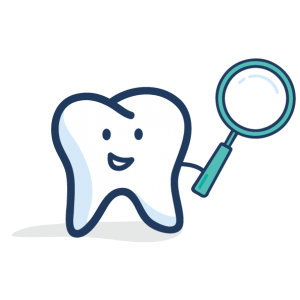
Your Baby’s First Dental Visit
What will happen at the first dental visit.
- Your child will sit in your lap
- The parent will sit facing the dentist or dental hygienist.
- The child will lie facing you with his or her head in the dentist or dental hygienist’s lap.
- You will be able to hold hands with and talk to your child.
- Your child may fuss or cry, but that is ok. It makes it easier to see inside the baby’s mouth. The exam will be over in just a few minutes.
- Click here to read more about the Age 1 dental visit.
If your child is older, he or she may sit in the dental chair for a gentle exam
During your visit, the dentist or hygienist may:.
- Clean your child’s teeth
- Provide a fluoride treatment
- Perform an x-ray
- Make suggestions on how to best care for your child’s mouth
- Schedule you for your child’s next appointment
Getting and Losing Teeth
When teeth start to appear.
- Baby teeth usually start to appear between 4-7 months of age. The lower teeth usually come in first. Once your baby’s teeth appear, it is time to start brushing them with a smear of fluoride toothpaste on an infant sized toothbrush. A smear of toothpaste is the size of a grain of rice.
- At 4 years old, your child’s jaw and facial bones will likely grow to make space between the baby teeth so that adult teeth have room to come in.
Losing Teeth
- Between the ages of 6 and 12 years, your child will start losing baby teeth. During these years, your child’s smile will have both adult and baby teeth. When teeth fall out, they can fall out in any order.
- Tooth Eruption Chart
Adult Teeth
- Usually the middle teeth (central incisors) are the first to come out around age 6 to 7 years.
- The ones on the sides of the middle teeth (lateral incisors) come out around age 7 or 8.
- Molars and canines can be lost at any time after age 8, and will be gone by age 9 to 12.
- Around age 12 years, your child will have a set of 28 permanent, adult teeth.
- Be sure to inspect your child’s teeth for signs of decay. If you see something that concerns you, call a dentist right away.
FTFT is funded by the Sadie & Harry Davis Foundation , Northeast Delta Dental and the US Department of Health and Human Services, Health Resources and Services Administration .
- Pregnancy Weeks
- Nursery Design
- Toddler Sleep
- White Noise
Your Baby’s First Dental Visit
You and your baby managed to survive the first round of teething ! Congratulations! But what do you do now that your precious nugget’s adorable little first chompers have finally emerged? Yes, brush them, but are dental visits really in the cards already? If you’re unsure you’re not alone! Here’s your guide to when to make that first appointment…and what to expect once you get there.
When do children need to visit the dentist for the first time?
Sooner than you think! Both the American Academy of Pediatrics (AAP) and the American Academy of Pediatric Dentistry (AAPD) recommend that your kiddo be examined by a dentist soon after their first tooth erupts…or within six months of their first birthday. Unfortunately, studies show that the average age when children actually first visit the dentist is three years old!
Perhaps this is because some parents are confused as to why a baby would need to see a dentist when their smile is only sporting one or two teeth . Here’s why:
Quells fears. When children visit the dentist early, they learn not to fear the dentist, which makes those future appointments go smoother.
Learn about dental care. Tots can learn early dental care habits that’ll help keep their teeth clean, healthy, and—fingers crossed—cavity-free.
Spot problems early. When dentists catch potential problems early, they can intervene before those issues become more serious.
Do children need to see a pediatric dentist?
Need? No. General dentists who enjoy kids can be a perfect fit. Just know that a pediatric dentist has two to three years specialty training following dental school and they only treat the smallest of patients. General dentists have about five weeks of training in treating kids.
How to prepare for your baby or toddler’s first dental visit:
Here’s the thing: Your tot has no reason to fear the dentist…they ’ ve never visited one before! So, it’s up to you to set the stage for a positive experience. Here are some ways to do just that:
Get the timing right. Choose an appointment time for when your child is at their most alert, happy...and well fed. That means it’s best to avoid the dentist during nap or feeding times, when kiddos will likely be hungry and fussy.
Call ahead. Waiting is hard for little ones. Before you head out the door, make sure your dentist is on schedule.
Give a preview. If your child is old enough, talk about what they can expect, like the cool dental chair that goes up in the air and the fun sunglasses they get to wear. You can also play dentist at home, so your child can get used to someone looking at their pearly whites up close.
Do this ahead of time. To make that first appointment go off without a hitch, see if you can fill out any paperwork before the appointment so you can focus solely on your tot during the visit.
What happens at the first dental appointment?
Your tyke’s first visit to the dentist is primarily a meet-and-greet to get everyone acquainted. You can expect the appointment to last around 30 minutes, and you’ll spend most of your time answering questions about the following:
- Family dentist history
- Pacifier use
- Bottle and breastfeeding schedules and habits
- Oral hygiene
- Sleeping habits
Your child’s dentist will also give a quick, no-stress first exam. Typically, your first-timer can sit on your lap while you lounge in the dental chair. This can work wonders for keeping littles calm, especially if they are nervous about a near-stranger peering into their mouth. During the exam, the dentist will:
Count teeth
Check for cavities and other dental issues
Assess development by looking at jaw, bite, gums, tongue, and the roof of your kiddo’s mouth
Clean teeth with a soft toothbrush if plaque is found to demonstrate brushing technique
Discuss a home dental-hygiene routine
Your child’s dentist might also offer a fluoride varnish treatment, which can help prevent, slow down, or stop tooth decay. (Fluoride is a mineral that works to strengthen tooth enamel.) The United States Preventive Services Task Force recommends that primary care physicians apply a fluoride varnish to all infants and toddlers starting when their first tooth appears (and through the age of 5), but if your child’s doctor hasn’t mentioned it, ask your pediatric dentist about it.
How often do toddlers need to go to the dentist?
Just like you, children should see a dentist once every six months. For toddlers, especially those who fear the dentist, it may be beneficial to inquire about visiting the dentist once every three months to establish trust and confidence.
Got more teeth questions? Here's help!
Why Do Toddlers Grind Their Teeth?
How to Brush Baby and Toddler Teeth
What Thumb-Sucking Has To Do With Dental Health
Toddler Teething and Night Waking
When to Expect Baby’s First Tooth…and Beyond!
View more posts tagged, health & safety
Have questions about a Happiest Baby product? Our consultants would be happy to help! Submit your questions here.
Disclaimer: The information on our site is NOT medical advice for any specific person or condition. It is only meant as general information. If you have any medical questions and concerns about your child or yourself, please contact your health provider.
You may also like
In the 48 contiguous United States, customers will be charged $59.50 + tax for the shipment of SNOO back to Happiest Baby. Added charges will apply for shipping to and from Alaska and Hawaii.
* An additional $185 shipping fee will be applied to SNOO purchases sent to Hawaii and Alaska.

- My member dashboard
- Edit your profile
- Change your password
- My dentist dashboard

Your child’s first dental visit
A child’s first visit to the dentist is an exciting milestone. But it’s also an important appointment that can help set them on a lifelong path toward good oral health.
The right time to schedule a first visit is within six months of their first tooth coming in, or no later than their first birthday. This timing is crucial because it’s important to:

Learn how to help your child avoid cavities and reduce health risks.
Find out who to call if there is an emergency.
Get to know your child’s dentist.
In the long run, you’ll also save money by learning how to take care of your child’s oral health and reducing the risk of more serious or expensive issues.
Getting your child ready
In advance of the visit, give them an idea of what to expect:
Go over what will happen at the appointment (more on that below). And be sure not to pass on any personal fear you may have of dentists to your child. Give them every opportunity to enjoy their first visit.
Explain why it’s important to go to the dentist and how it keeps them healthy.
Take time to answer any questions they may have.
Try to schedule a morning appointment when your child is likely to be more awake and attentive.
The day of the visit, go over what to expect one more time. Don’t share any negative experiences that you or other family members may have had with the dentist – instead, remain calm and positive! Your child will likely mirror the feelings you express about the appointment.
It can help to bring a comfort item or quiet game so they can have a little fun while they wait. It’s also an option to plan a positive reward for after the appointment.
What will happen during the visit?
During the routine exam, the dentist will check your child for cavities and review overall growth and development. The dentist will also demonstrate how to properly brush and floss your child’s teeth at home to make sure you’re as effective as possible in removing the plaque bacteria from all tooth surfaces.
To help you continue to care for your child’s oral health, you and your dentist will also:
Discuss food, drinks, and habits that can cause cavities and healthy alternatives
Review the vital role fluoride plays in strengthening tooth enamel and protecting your child’s smile
Be given helpful information for preventing accidents as your child grows
Why is it important to practice good oral health care from an early age? Because untreated oral health issues will continue to worsen over time – and more than half of children ages 6 to 8 have had a cavity in at least one baby tooth. 1
By taking your child to the dentist, you’re pointing them toward the path of good oral health. Prepare a little in advance to make sure it’s a great appointment!
1 Centers for Disease Control and Prevention

- About Doctor
- Staff Directory
- Testimonials
- Financial/Insurance
- Appointment Request
- About teeth
- Common Problems
- New Patient Forms
- Emergency Info
- First Visit
- Early Dental Care
- Sedation Dentistry
- Special Needs Dentistry
Read All About It
Dental related articles.
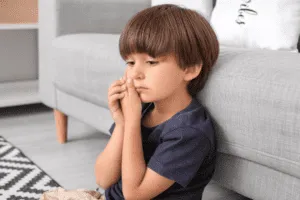
First Dental Visit: When To Go and What To Expect for Children
A question we often hear is, “When should my child first go to the dentist and what should we expect on that day?” Read on to see just when you should take your child to the dentist and what the initial visit to a pediatric dentist may be like.
When Should Your Child Have Their First Dental Visit?
The American Academy of Pediatric Dentistry recommends your child’s first visit to the dentist should occur within six months after your child’s first tooth appears, but no later than by the child’s first birthday.
You may be wondering, though, when your child will get their first teeth. From birth, children usually have 20 primary teeth partially formed under the gums. The first teeth tend to erupt and come in through the gums from the age of six to 12 months. Beyond that, most children will have their full set of primary teeth by age three.
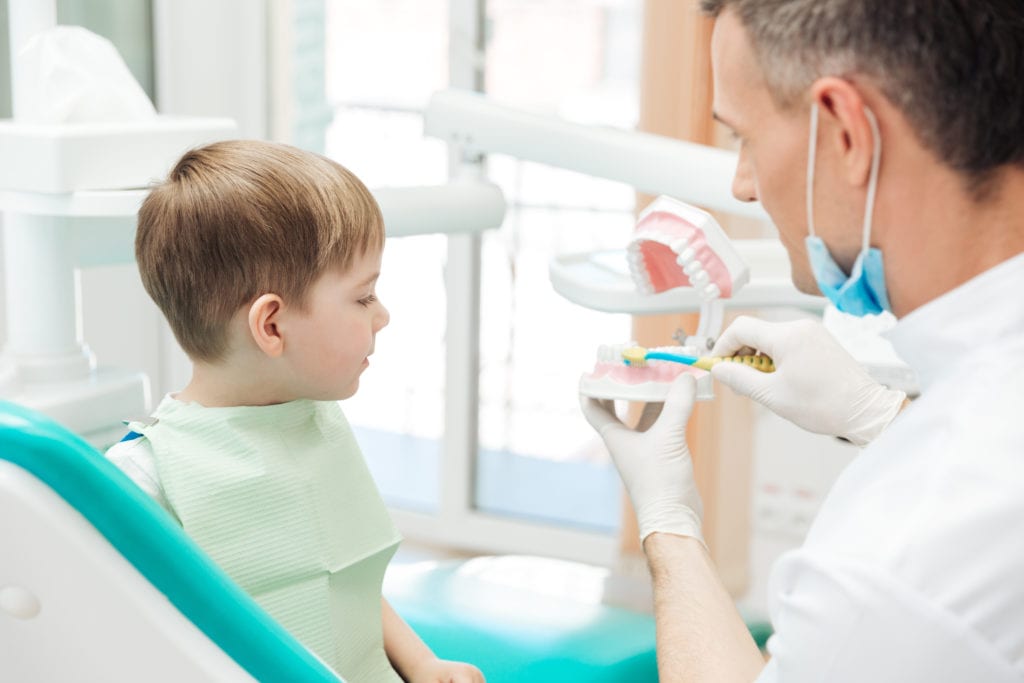
It’s important to take care of those primary baby teeth for many reasons, including the fact that decay in the baby teeth can sometimes lead to decay in the permanent teeth. Establishing a routine visit to the dentist for your child is not only recommended but prudent. But what can you expect when you get there?
What Should You Expect During Your Child’s First Trip To The Dentist?
All pediatric dentists have their own unique ways of welcoming a child for their first dental visit and making them feel comfortable while they are there. The experience sometimes starts outside the office with colorful signage on the building or door.
Once inside the office, the waiting room can be transformed into a place of play with books, board games, building sets, and video games. A lot of offices will hold drawings to engage the kids. For example, having a large glass jar filled with marbles (or anything that’s fun to count) and slips of paper with pencils on a table, so kids can guess the number of items in the jar, enter the contest, and qualify to win a prize.
Making the visit fun for your child is the goal to decrease resistance to visiting the dentist in the future. The dental office staff play a huge role in making the visit pleasant for your child. Assistants should be friendly, engaging, and physically be down at the child’s level to interact one-on-one with them.
What Is Involved In The First Dental Exam?
When your child is called back for their dental exam and cleaning, expect the hygienist to greet you with a smiling face and happy tone of voice. The hygienist will normally welcome you, introduce themselves to you (AND to your child) and then show you to an exam room.
At this point, because the dental tools tend to be intimidating to a young one (and even some adults), most hygienists will make a game of introducing and explaining the equipment that dentists use. They may start by asking if your child has any troubles in their mouth or if their teeth are hurting and whether they brush and floss.
Then, they might ask if your child knows how many teeth they have. This is a great ice breaker, because kids love to count. The hygienist will generally get their ‘teeth counting tool’ (just a pick) and make a huge deal of counting all the teeth on the top and all the teeth on the bottom, and say something like, “Wow! You have ten teeth on top and ten on the bottom. Do you know how many teeth that is in total? You have 20 teeth!!”
The hygienist may use words and phrases your child can relate to. For example, when the cleaning and exam starts, your child’s exam chair will be tilted backwards and down, which can be scary for a child. This is the perfect opportunity for your little one to ‘go on a space adventure in a rocket’. And to get a reluctant child to open wide enough for the exam, you may hear, ‘Open your mouth big, like a hippo, for me.”
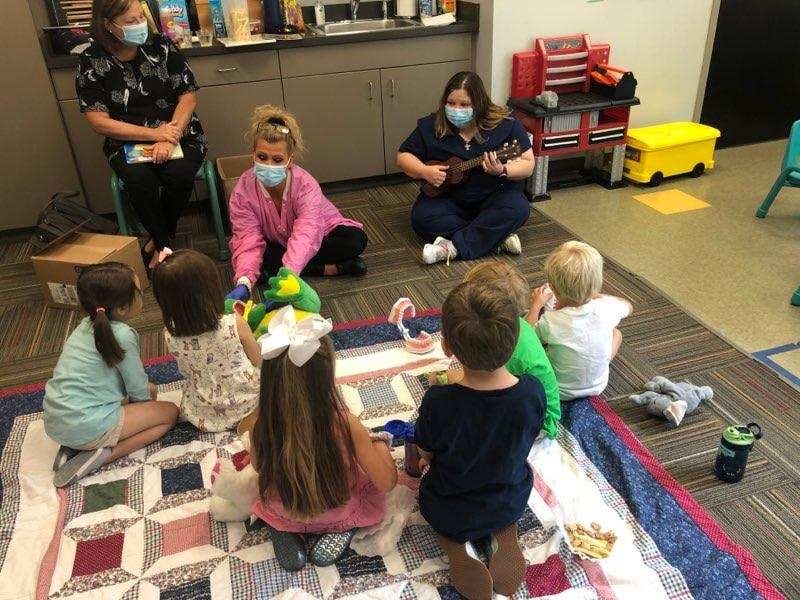
Cleaning and polishing teeth is done by the “tooth tickler.” The instrument used to rinse, remove water and paste, and blow air is either a ‘squirt gun’, an ‘elephant’s trunk” or a ‘tooth dryer’ (similar to a hair dryer) depending on its function at the time. Floss helps to remove the ‘sugar bugs’ from between the teeth. And fluoride varnish is usually a “superhero protection paint.”
When it comes time for X-rays, hygienists call the protective shield a ‘heavy blanket’ and may joke that it weighs more than your child. Actually taking the X-rays is compared to taking movie star glamour shots or something similar. You get the idea.
Anything to calm your child’s fears and keep the appointment experience fun is the end goal, so that future appointments will be looked forward to. Some pediatric dental offices will even show movies or cartoons on a screen in the waiting room or in the exam room to help alleviate anxiety.
Of course, the dentist will come and examine your child after the cleaning. This can be an area of uncertainty and transition for your child, so a lot of dentists will offer prizes from the treasure chest for being a good patient.
Your child may also receive a bag filled with helpful items designed to encourage your child to brush and care for their teeth properly. Colorful toothbrushes, toothpaste, floss picks, timers, toy prizes, and even story books about trips to the dentist may be included. Your child may be encouraged to use the timer while they brush their teeth for two minutes, two times per day (Or they can sing their ABC’s in their head, twice!).
Tips For Your Child’s First Dental Visit
As soon as your child gets their first tooth, go ahead and schedule an appointment close to their first birthday.
Schedule an appointment during the time of day that is best for your child, when they are most calm, rested, and cooperative.
If you fear the dentist, don’t show that anxiety to your child. Stay positive and trust in your pediatric dental professional.
Don’t use bribes to entice your child to go to the dentist nor use a trip to the dentist as a form of punishment.
Preventive Care Can Lead To A Lifetime of Dental Health
Just like with a well-baby check at the doctor, bringing your child to the dentist at a very early age can help to establish positive dental care routines that will ensure oral health over a long period of time. Setting up your child’s dental home in advance is a wise idea should issues involving their teeth arise, either cavities or injuries.
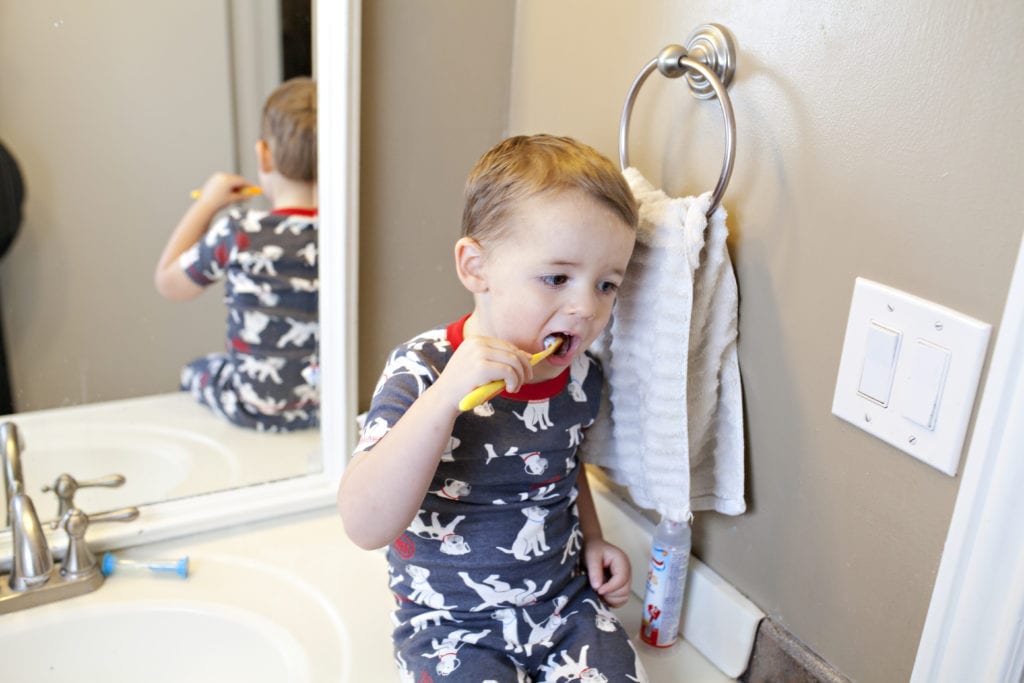
Good dental health practices can save your child from potentially painful future procedures and save you time and money in the long run. Most importantly, working with a pediatric dentist that can put your child at ease and make them want to go to the dentist may be a key factor in whether your child partakes in dental healthcare throughout their life.
To discuss any concerns you may have about your child’s first trip to the dentist, contact us here at Hurst Pediatric Dentistry.
19 INVERNESS CENTER PARKWAY, STE 250, BIRMINGHAM, AL 35242
TEL: 205.969.7454
E-MAIL: [email protected]
2018 © ALL RIGHTS RESERVED | PRIVACY POLICY | TERMS AND CONDITIONS
Site by Trustway Marketing Powered by Kyrios Systems
What To Expect At Your Child's First Dentist Visit

The ADA and pediatricians recommend that every child see a dentist by the time their first tooth comes in or when they turn 1 year old (whichever comes first.) Since most dental problems are preventable, these early visits can help your baby or toddler get a jump-start on having healthy teeth for life. Knowing what to plan for with kids’ dental care can help you minimize any anxiety or nervousness so that future checkups are as easy as possible.
Risk Of An Untreated Rotten Baby Tooth
When baby teeth have issues, fixing them isn’t as simple as just pulling the tooth so that the new one can grow in. Your baby or toddler needs that primary tooth to act as a space saver for the adult tooth that’s growing in underneath. Otherwise, it can lead to serious issues like orthodontic complications or even speech impediments.
Untreated tooth decay in rotten baby teeth actually sets your child’s permanent teeth up for unnecessary infection. Since decay and bacteria can spread to the developing teeth underneath, delaying dental care can lead to serious complications.
Kids dental care with a family or pediatric dentist will revolve around preventative strategies and early intervention, to avoid rotten baby teeth and unnecessary side effects. In most cases, the best treatment is to fill the cavity with a small filling as soon as it ruptures through the enamel (because baby teeth can decay at extremely fast rates!)
When Should Your Child First Visit The Dentist?
Don’t wait until there’s a toothache before you schedule your child’s first dental visit. In fact, a baby’s first dental appointment needs to happen before their first birthday or when their first tooth comes in. Your family or pediatric dentist will want to evaluate for things like:
- oral development
- tongue ties
And as teeth start coming in, they’ll also screen for:
- baby bottle tooth decay
- impacted teeth
- overbites and underbites
- thumb and finger sucking
- speech problems
Since most of these conditions are best handled as early as possible, seeing your family or pediatric dentist by the recommended age of 1 will help you ensure that your baby or toddler has the best chances at a future healthy smile. Even though those teeth will eventually fall out and get replaced with permanent adult teeth, some of them will need to last well until when your child is in junior high.
What Happens At My Baby/Child’s Cleaning Appointment?
Once your baby’s 1-year old dental checkup is over, you’ll want to plan on scheduling regular six-month checkups just like the rest of your family members. Since every child is different when it comes to what they’re comfortable with or able to sit through, your family or pediatric dentist will play it by ear when it comes to their first cleaning.
It can help to bring your toddler or young child in to watch your own cleaning (or a sibling’s) as long as you have another adult there to help hold them. This experience can minimize any fear or anxiety related to their first dental cleanings .
For the most part, a toddler’s first dental cleaning will be when they’re around 2 or 3 years old. Again, this depends on the child. The dentist or hygienist will likely ease into the cleaning by “counting” your child’s teeth, using a special polishing tool (“electric toothbrush”), scaling off plaque (“using a toothpick”) and then applying fluoride (“vitamins”) to ward off cavities.
Depending on how cooperative your toddler or child is, your dentist will eventually start taking yearly checkup X-rays to screen for cavities and impacted teeth. This could be as early as 2-3 years old or as late as age 5.
Overview Of Your Childs First Dental Appointment
It’s super important for you to bring your baby or toddler to the dentist every six months for checkups. Preventative visits help you avoid common dental problems and eliminate the risk of associating the dentist’s office with pain (which can happen if you wait until your child as a toothache or other dental problem.)
Baby’s first dental visit needs to be scheduled by the time their first tooth pops through or by their first birthday (whichever one happens first). Ask your family dentist if they see children or if it’s ok for your toddler to watch during your next checkup. The more familiar they are with the checkup and teeth cleaning experience, the better chances there are that your child won’t be as nervous when it’s time for their own visit.

Make your inbox smile!

Related Articles

Coffee teeth stains are a bad side effect of drinking coffee. The natural pores of our tooth enamel allow stain buildup to accumulate over time.

Dentophobia is an intense fear or anxiety related to dental care or visiting the dentist. Severe dental anxiety that it can lead to very poor dental health.

Flossing with a permanent retainer can be challenging since there is a small wire that’s cemented to the tongue-side of your bottom front teeth.

Did you experience a break or chip in your tooth, or was it tartar? Tartar breaking off can leave a 'hole,' making it hard to distinguish from a broken tooth.

Gum bumps vary in severity and cause, from infections to minor injuries.

There are two main types of mouthwashes within each brand: (1) fluorides and (2) antiseptics.
Recommended reads
An official website of the United States government
The .gov means it’s official. Federal government websites often end in .gov or .mil. Before sharing sensitive information, make sure you’re on a federal government site.
The site is secure. The https:// ensures that you are connecting to the official website and that any information you provide is encrypted and transmitted securely.
- Publications
- Account settings
Preview improvements coming to the PMC website in October 2024. Learn More or Try it out now .
- Advanced Search
- Journal List
- Healthcare (Basel)


Preparing Children for Their First Dental Visit: A Guide for Parents
Simone bagattoni.
1 Unit of Special Needs Dentistry and Paediatric Dentistry, Department of Biomedical and Neuromotor Sciences, University of Bologna, 40125 Bologna, Italy
2 Unit of Pediatric Dentistry, Department of Surgical, Medical and Molecular Pathology and Critical Care Medicine, University of Pisa, 56126 Pisa, Italy
Francesca Nascimben
Elena biondi, raquel fitzgibbon, lisa lardani, maria rosaria gatto, gabriela piana, katia mattarozzi.
3 Department of Experimental, Diagnostic and Specialty Medicine, University of Bologna, 40126 Bologna, Italy
Associated Data
The data presented in this study and the information booklet are available on request from the corresponding author.
The aim of the study was to test an information booklet containing suggestions to parents on how to prepare their child for the first dental visit. Forty-five children and one parent per included child took part in the trial. Children were randomized in two groups; the information booklet was e-mailed to the parents of the study group. At the end of the visit, the dentist and the parent evaluated the child’s behavior through the Frankl Behavior Rating Scale (FBRS) and the utility of the booklet through a Likert scale. The children evaluated the pleasantness of the visit and the perceived pain through the Wong–Baker FACES ® Pain Rating Scale (WBFPRS). Parents evaluated the information booklet as highly understandable and useful. According to the dentist, informed children were more cooperative (FBRS median score: 4; IQR: 3.5–4) than the control group (median score 3; IQR: 2–4) ( p = 0.013; Mann–Whitney U test). Children prepared with the booklet reported less pain (WBFPRS: 0.40 ± 0.82 vs. 1.42 ± 1.99; p = 0.034; t -test;) and tended to evaluate the visit as more enjoyable (WBFPRS: 1.1 ± 2.14 vs. 2.75 ± 3.43; p = 0.064; t -test) than unprepared children. The information booklet increases the child’s ability to cooperate during the visit and could represent a useful instrument for the clinical practice.
1. Introduction
In medicine and dentistry, the treatment’s effectiveness derives not only from the competence of the physician but also from the ability to create an effective relationship with the patient. When the patient is a child or a special-needs patient, the relationship is more complex [ 1 , 2 ]. The dentist has a dual task: to deal with the child’s possible resistance arising from fear of the unknown and potentially threat; to deal with parents’ behavior, often unprepared to adequately guide their child toward dental care [ 3 ]. Obtaining the child’s and parents’ cooperation, while promoting a positive attitude toward dental care, is a primary goal for the pediatric dentist [ 4 ].
In this context, preoperative communication is very useful, but often underestimated. Many studies have shown how the information children receive about the dental environment before the visit can influence their behavior, both positively and negatively. A previous study showed that presenting pictures of children enjoying the dental visit promotes a positive relationship with the dentist [ 5 ]. The study showed a reduction in anticipatory anxiety, the unpleasant sensation that afflicts children during their first dental experience [ 5 ]. The study by Melamed et al. [ 6 ] showed that children that were previously prepared for restorative procedures watching a video of a peer undergoing the same procedure can overcome their fears and be more cooperative. The children of the control group, who were shown a video with nondental content, reported a higher level of anxiety.
Even though the child acquires information of the therapy’s steps and instruments, they have never experienced them directly; thus, they can be frightened of what they will feel. It is, therefore, necessary to provide preparatory sensory information; this helps the child to cope with fear and pain, especially when combined with the use of distraction. Distraction alone may not be enough if the child, unaware of what will come, is tense and unable to distract themself; the prepared child knows what awaits them and is more easily distracted [ 7 , 8 ]. As shown in several studies, the parent’s state of anxiety greatly influences that of the child; hence, the preparatory information is also useful for reassuring the parent [ 9 ].
To date, not enough attention has been paid to the role of communication before the first dental visit to encourage the child’s cooperation and avoid dysfunctional behaviors. The dentist can provide parents with the information they need to adequately prepare the child for treatment. The present study aimed to investigate the effectiveness of an information booklet to promote pediatric patients’ cooperation during the first dental visit. We hypothesized that offering guidance to parents on how to prepare their children for the first visit would (I) reduce the degree of unpleasantness of the visit for children, (II) reduce the child’s pain perception, (III) increase the child’s cooperation, and (IV) be appreciated by parents.
2. Materials and Methods
This was a single-center parallel-group study. We adopted a single-center approach to guarantee consistency regarding equipment, environment, and data collection. The study took place at the Unit of Pediatric Dentistry of the Department of Biomedical and Neuromotor Sciences of the University of Bologna.
The study design was approved by the Ethics Committee of Area Vasta Emilia Centro (CEAVEC) on 23 January 2019 (protocol No. 0033664, ref 69/2019/SPER/AUSLBO) and registered on ClinicalTrial.gov ( {"type":"clinical-trial","attrs":{"text":"NCT05608720","term_id":"NCT05608720"}} NCT05608720 ).
2.1. Sample Size
Preliminary results from a pilot study carried out by the same scientific committee (not published data) evidenced an average of visit pleasantness rated by children equal to 0.9 in the study group and 2.7 in the control group. Consequently, at an alpha level equal to 0.05 with a power of 80% for a two-sided test and an allocation ratio of 1:1 between the two groups, a sample size of at least 21 children was needed in each group.
2.2. Recruitment and Randomization
Eligible participants were parents and their children who made an appointment for a first visit at the Unit of Pediatric Dentistry of the Department of Biomedical and Neuromotor Sciences of the University of Bologna between January 2019 and September 2019. The parents of 158 children were initially contacted by telephone by the principal investigator, a pediatric dentist, to check the exclusion/inclusion criteria and to obtain a preliminary verbal informed consent for study participation. A total of 102 children were excluded because they met one or more of the exclusion criteria (i.e., previous dental visits, intellectual disability, and mother tongue other than Italian). Parents were then emailed information regarding the objective of the study to obtain formal informed consent to participation. Of the 56 eligible children, eight did not show up on the day of the visit, and the parents of three children did not consent to participation in the study. Forty-five children and one parent each were included in the study. After obtaining informal consent by e-mail, participant randomization was performed. Each participant was assigned an alphanumeric identification code. The parent and respective child were identified with the same number and a different letter code (example: child C_01, mother M_01, and father F_01). The participants were randomly assigned to the study or control group.
2.3. Procedure
Two days before the dental visit, the parents within the study group received the information booklet as a PDF file by e-mail. The parents and children in the control group received the usual information (i.e., day, time, place of the appointment, and bureaucratic information) along with a thank you for participating in the study.
The day of the dental visit, written informed consent was collected, and the children of both groups were visited by a pediatric dentist on duty at the time, blinded to patient group allocation. The first dental visit consisted of a visual examination of the oral cavity with the aid of a dental mirror and a dental probe to assess the oral health status of the child. A tell–show–do approach was utilized. No operative procedures (e.g., fillings or X-rays) were performed. At the end of the dental visit, the principal investigator handed the pediatric dentist, the parent, and the child a paper questionnaire.
The child’s questionnaire investigated the pleasantness of the visit and the perceived pain using the Wong–Baker FACES Pain Rating Scale (WBFPRS) with corresponding scores from 0 to 10 [ 10 ] ( Figure 1 ).

Wong–Baker FACES Pain Rating Scale.
The dentist’s questionnaire investigated the child’s behavior during the visit using the Frankl Behavior Rating Scale (FBRS) [ 11 ] (1 = definitively negative, 2 = negative, 3 = positive, and 4 = definitively positive).
The parent’s questionnaire investigated the behavior of the child during the dental visit through the FBRS; if part of the study group, it also investigated the evaluation of clarity, comprehensibility, usefulness, ease of application, and truthfulness of the booklet through the Likert scale to five points (1 = very little, 5 = very much).
2.4. Information Booklet Description
The information booklet was ad hoc written on the basis of the effectiveness of communication in the doctor–patient relationship [ 12 ]. The choice of concepts and words was based on the literature on stress and the nocebo effect [ 13 ]. The objectives were to increase knowledge about the first dental visit and to prevent the child from activating negative expectations and aggressive or avoidance responses. The booklet was written in Italian, and it consisted of four pages with texts and pictures showing a parent and a child talking about the visit. Specifically, the first part of the booklet explained to parents the importance of the first dental visit in promoting a positive attitude toward the dental environment. The second part suggested how the parent should prepare the child for the visit: “inform the child about the visit to the gentle dentist using truthful and positive words”; “accept the child’s fears and concerns without denying them”, using phrases such as “you must not be afraid”; “prepare the child for some simple procedures, such as ‘sit down, it is time to count your teeth’”; “welcome the concern and fear expressed by the child”; “propose a cartoon about Peppa Pig’s first dental experience ( https://www.youtube.com/watch?v=xLN0smEFoPI , Peppa Pig episode 2 × 37 ‘At the Dentist’, accessed on 15 December 2018)”; “do not use words with negative emotional valence”; “do not promise that unpleasant events will not occur”; “do not promise gifts”; “do not talk about negative dental experiences” ( Figure 2 ). Easy-to-understand language and colorful images consistent with written information were used to make communication more effective. The booklet is freely available upon request to the corresponding author.

Example of easy-to-understand language and colorful images adopted.
2.5. Statistical Analysis
Statistical analysis was conducted with SPSS software (27.0 version, SPSS Inc., Chicago, IL, USA). A Kolmogorov–Smirnov test verified the Gaussian distribution of the variables. Consequently, the mean and standard deviation were calculated for WBFPRS scores; the median and interquartile range (IQR) were calculated for FBRS scores. The t -test and Mann–Whitney U test were used for the comparison of continuous variables and the chi-square test was used for categorical variables. The significance level was set at p < 0.05. The biostatistics were masked to the group allocation.
3.1. Sample
Twenty-one children were included in the study group, along with 24 in the control group. Descriptive characteristics of children, parents, and operators are described in Table 1 . No significant differences were found between the two groups.
Descriptive characteristics of the study and the control group.
3.2. Information Booklet
The average scores provided by the parents concerning clarity, comprehensibility, usefulness, ease of application, and truthfulness of the booklet are shown in detail in Table 2 .
Evaluation of booklet’s contents.
The difference in pain reported by the children during the visit between the study group (0.40 ± 0.82) and control group (1.42 ± 1.99) was statistically significant ( p = 0.034; t -test). As shown in Figure 3 , children in the study group reported less pain than the control group.

Reported pain by children in the two groups.
The difference in pleasantness reported by the children during the visit between the study group (1.1 ± 2.14) and the control group (2.75 ± 3.43) was not statistically significant ( p = 0.064; t -test). As shown in Figure 4 , children in the study group tended to evaluate the visit as more pleasant than the control group (lower scores indicate higher approval).

Reported pleasantness of the visit by children in the two groups.
The difference in children’s behavior assessed by the operators between the study group (median: 4; IQR: 3.5–4) and the control group (median: 3; IQR: 2–4) was statistically significant ( p = 0.013; Mann–Whitney U test). As shown in Figure 5 , operators judged the children in the study group as more cooperative compared to the control group.

Dentists ‘evaluation of children’s behavior.
The difference in children’s behavior assessed by parents between the study group (median: 4; IQR: 3–4) and the control group (median: 4; IQR: 2.25–4) was not statistically significant ( p = 0.347; Mann–Whitney U test).
4. Discussion
Negative, painful, and invasive experiences play a central role in the etiology of dental fear, and they often date back to childhood and adolescence. Children who had a negative experience since the first approach to the dentist have a higher risk of suffering from dental fear than children who had only a negative or painful experience after several positive experiences [ 14 , 15 ]. Hence, this shows the importance of setting up a structured first dental visit that activates positive experiences and nontraumatic memories.
This is the first study in the literature to focus on the child’s preparation before the first dental visit. This preparation took place in a safe environment and by an affectively relevant person such as a parent informed by the booklet. Parents appreciated the information booklet considering it clear, easy to use, and truthful. Our results show that guiding parents to prepare their child for the first dental visit has a reassuring effect on both sides. Parents felt involved in the process from the beginning and felt ready to explain the situation to their child. Children showed a more cooperative behavior, and they tended to find the visit more enjoyable than the children in the control group. Notably, they felt less pain during the procedure. For clarity, the first dental visit in both groups did not include operative or invasive procedures. The reported pain is probably an expression of the stress experienced during the visit. However, the lower reported “pain” of the study group could be explained by less anticipatory anxiety and an increased sense of control toward an unknown experience [ 16 ]. Many studies agreed in identifying negative experiences and anxiety as powerful modulators of pain perception, including in dentistry [ 17 , 18 ]. However, the relationship between anxiety and preparation may have a twofold trend; too much or too little information can increase anxiety levels [ 19 ]. Therefore, it is important to pay attention to the quality and quantity of information; the booklet provides the parent with specific indications on what to say and what not to say to the child [ 20 ].
An important result emerged from the pediatric dentists’ evaluation: children in the study group were more cooperative than the unprepared children. This outcome represents a great advantage for the pediatric clinician and potentially even more so to the general practitioner. In contrast, parents did not see their children’s behavior as more cooperative. This could be explained by the fact that both groups were approached by experienced pediatric dentists, well trained in dental behavior management [ 21 ]. An increase in the number of participants could lead to a more consistent result, in accordance with the dentist’s assessment.
A limitation of the study concerned using single-item measures. However, we based our methodology on validated psychometric scales used to rate pain, emotional stimuli, and behavior during the visit. Randomization gave control over confounding variables that could not be held constant or measured, such as the reason for the first visit, the parents’ gender, age, and educational level, the parents’ personality traits and previous dental experiences, the child’s personality traits, or any other unknown confounding factors that could differentiate the group composition. Bias, potentially derived from the pediatric dentist who visited the child, was controlled by masking the procedure. Considering the aim of the study, masking of participants could not be applied. Data analysis potential bias was controlled by masking the biostatistics.
In accordance with the literature, our results confirm the importance of preparing parents and children for their first dental visit through booklets, simulation programs, or smartphone applications [ 22 , 23 ].
A further research project could evaluate the efficacy of the booklet in the long term (i.e., during dental treatment) and for children with previous negative dental experiences. In addition, it would be interesting to test the information booklet on general dental practitioners and to extend an adapted version to other care settings involving children. Lastly, a further evaluation of the difference between a written booklet and audiovisual material such as a video of a first visit could be tested.
5. Conclusions
Guiding parents to prepare children at home increases the ability to cope with the dental visit and decreases the perception of discomfort and pain. The information booklet is easy to implement in the clinical practice, both in private and in public facilities, and the cost is negligible.
Acknowledgments
We acknowledge the participants who made this study possible.
Funding Statement
This research received no external funding.
Author Contributions
Conceptualization, G.P. and K.M.; methodology, K.M. and S.B.; investigation, F.N., E.B., and L.L.; data curation, S.B., M.R.G. and K.M.; writing—original draft preparation, S.B., F.N., R.F., and K.M. All authors have read and agreed to the published version of the manuscript.
Institutional Review Board Statement
The study was conducted in accordance with the Declaration of Helsinki and approved by the Ethics Committee of Area Vasta Emilia Centro (CEAVEC) on 23 January 2019 (protocol No. 0033664, ref 69/2019/SPER/AUSLBO).
Informed Consent Statement
Informed consent was obtained from all subjects involved in the study.
Data Availability Statement
Conflicts of interest.
The authors declare no conflict of interest.
Publisher’s Note: MDPI stays neutral with regard to jurisdictional claims in published maps and institutional affiliations.
Helping Your Baby Reach Greater Wonders
Making Baby’s First Dental Visit a Happy Milestone

- Plan to take your baby to their first dental visit by age one.
- There are five steps you can take to prepare for your baby’s first visit.
- Going to the dentist is a great way to get your child excited about brushing.
- Comfort, positivity, reminders, and touch can all help your child through the first dental visit.
As a common fear, even for some adults, going to the dentist doesn’t exactly evoke warm and fuzzy feelings. I was especially worried about this with my daughter, who very early on made routine pediatrician appointments feel like a wrestling match. To my surprise, she actually enjoyed her first dental appointment. No joke (or wrestling)!
If that sounds like an impossible task, let me change your mind with a full-blown breakdown of your baby’s first dental visit. From what to expect to how to prepare, stay put to learn how to make your baby’s first dental visit a happy milestone!
When Should Babies Have Their First Dental Visit?
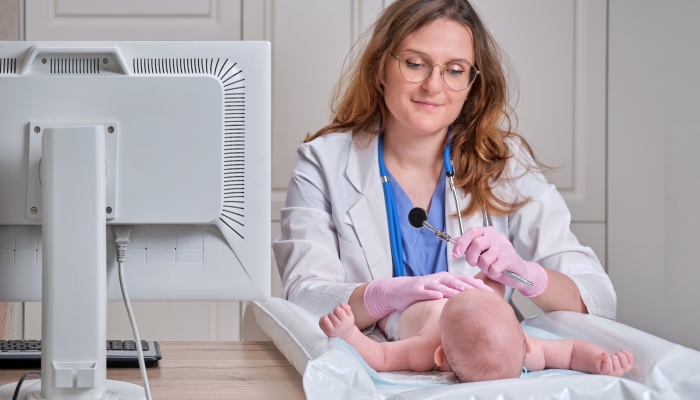
Babies should have their first dental visit by the time they’re one year old. Another rule of thumb is to have their first appointment no more than six months after you see their first tooth come in. I know it might seem like it’s way too early to start, but the truth is it’s critical to maintaining their first teeth.
Suchitra Nelson wrote in the study, Do baby teeth really matter? Changing parental perception and increasing dental care utilization for young children 1 1. Nelson, S., Slusar, M. B., Albert, J. M., & Riedy, C. A.. Do baby teeth really matter? Changing parental perception and increasing dental care utilization for young children. Contemporary Clinical Trials . 2017;59, 13–21. https://doi.org/10.1016/j.cct.2017.05.002 , that “Unlike other medical illnesses, childhood dental caries is entirely preventable with adequate self-management strategies by parent/caregivers that include regular preventive dental care and appropriate oral hygiene habits.”
This regular preventative dental care, Nelson states, allows the dentist the all-important task of checking your child’s teeth for tooth decay, pacifier teeth , defects, or anything that may require extra care or examination. Your baby’s first dental visit also establishes their dental care and begins getting them used to the process of dental visits.
How to Prepare for Your Baby’s First Dental Visit
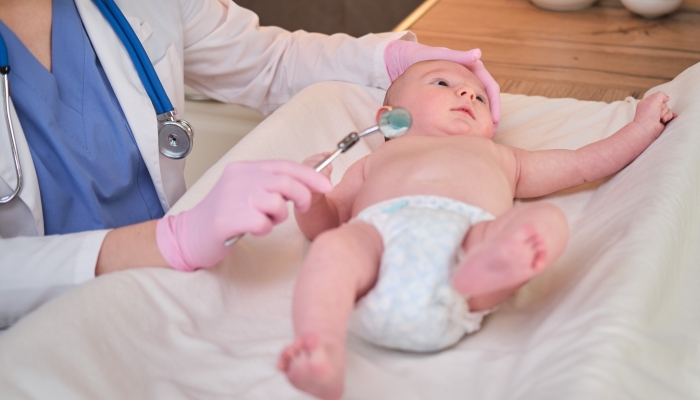
Preparation is key to a successful first dental visit. If you’re not sure where to start, here are some ideas of what you can do to help things go smoothly the day of:
- Find a Dentist: An obvious point, I know, but it’s worth mentioning for the simple fact that not all medical professionals are created equal. Find a pediatric dentistry with a good bedside manner that goes above and beyond to welcome your child.
- Talk It Up: This part is critical. Talking about going to the first appointment in an exciting way not only put my daughter in the right frame of mind, but it didn’t catch her off guard when the time came for us to go.
- Demonstrate the Process: If talking the process through isn’t interesting to them, try other resources like books or videos about the dentist. Seeing everything firsthand can be very disarming!
- Take a Tour: It’s always a great idea to take your child on a tour of the dental office; that way, their first time in the office isn’t on the day of their first appointment. They may take some comfort in the familiarity.
- Schedule Carefully: As with other appointments, things usually go better when your child is well-rested. Pick an appointment time either early in the morning after they wake or after a good long nap.
What to Expect During Your Baby’s First Dental Visit
At your child’s first dental visit, you can expect to be there for no more than 45 minutes. Their dentist will conduct a regular exam which includes checking your baby’s teeth for tooth decay, pacifier teeth, gum condition, and bite. If they think it necessary, they may do a gentle cleaning and polish too. Unless there’s an issue, you shouldn’t expect X-rays since their baby teeth will eventually fall out.
During this visit, the dental assistant and the dentist alike are great at getting your little one excited about maintaining their oral health, too, giving them a careful demonstration of cleaning techniques. This worked wonders with my daughter! She was all about trying to brush precisely how the dentist showed her after her first appointment.
Also, don’t be afraid to use this time to ask questions! Maybe you’re wondering why your baby’s teeth are coming through in the wrong order or how their thumb-sucking might affect their mouth over time. Now is the time to ask.
Tips to Help Your Baby Feel Comfortable During The First Dental Visit
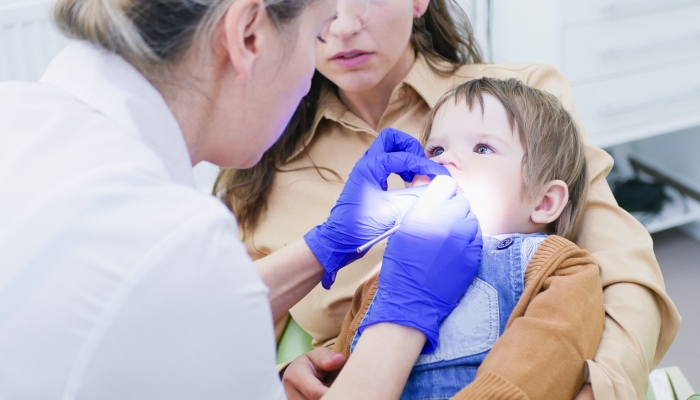
Your little one may feel a bit nervous during their first appointment, but there are plenty of ways you can make them feel comfortable from start to finish.
- Bring Comfort: If your little one has a favorite stuffed animal , blanket, or toy, consider bringing it along to the first appointment. It’ll bring them some comfort and maybe even act as a tool for demonstrating procedures to them.
- Be Positive: Babies often look to their parents to confirm whether or not certain situations are okay, reading their facial expressions and tone. Be a source of positive reinforcement with each step of the dental exam.
- Remind Them: If you prepared them for the appointment by explaining the process, reading a book, watching a video, or whatever you choose, remind them of those demonstrations. Recalling them might calm their nerves.
- Physical Touch: Whether their dentist allows your child to do a simple lap exam or they prefer them to sit in the dental chair, any physical separation can be distressing to them in a new scenario. Offer as much physical touch as you can, whether it be holding their hand or just keeping your hand on their arm or leg.
What are some signs that my baby may have dental problems that need to be addressed?
The easiest sign to spot would be a rejection of foods they usually enjoy or visible pain when they try to chew. Irritation from particularly hot or cold foods or drinks may also be a sign of tooth pain. Any swelling of the gums or jaw, tooth discoloration, bad breath, or even ulcers are all signs to consult your little one’s pediatric dentist as soon as possible.
How often should my baby have dental check-ups after the first visit?
As with adults, babies should continue to be seen every six months after their first dental visit. It’s essential to stick with that schedule even if your child receives good reports at every appointment. A missed dentist appointment could mean a missed issue that could have been easier to take care of from the get-go.
- Nelson, S., Slusar, M. B., Albert, J. M., & Riedy, C. A. (2017). Do baby teeth really matter? Changing parental perception and increasing dental care utilization for young children. Contemporary Clinical Trials , 59 , 13–21. https://doi.org/10.1016/j.cct.2017.05.002
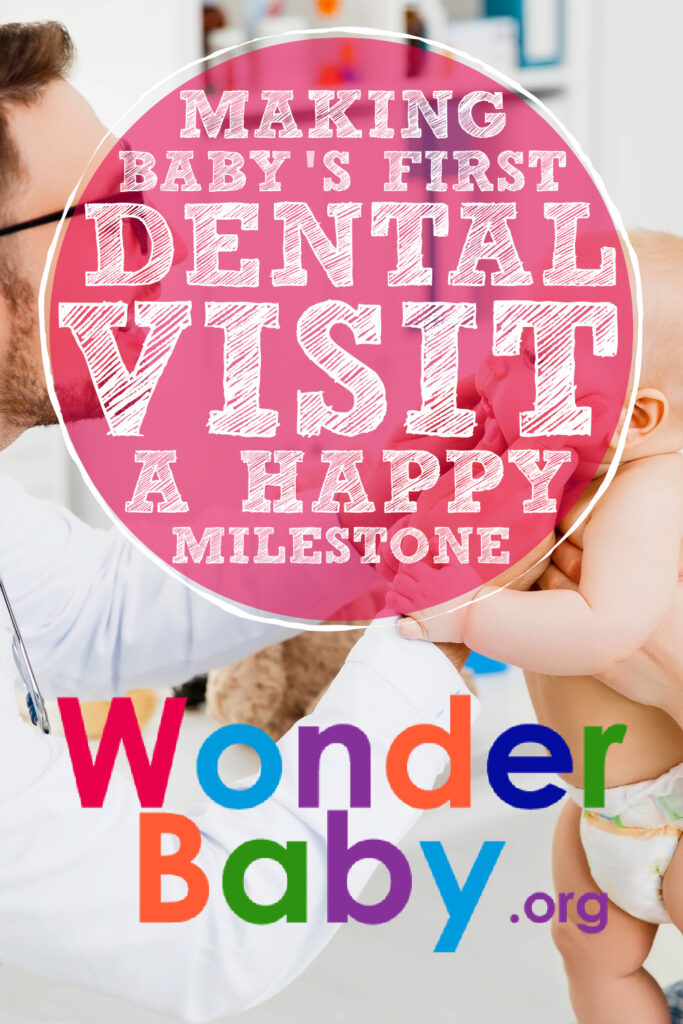
Related Posts
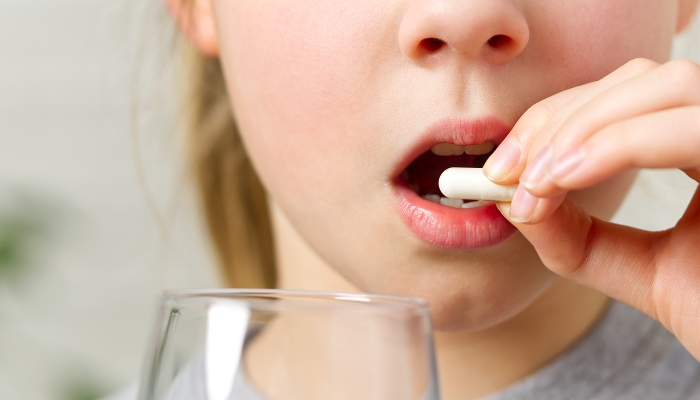
Health & Nutrition
Making Medicine Manageable: Teaching Kids To Swallow Pills
Teaching your child how to swallow a pill is an important skill as they grow older. Find out how to do it here.
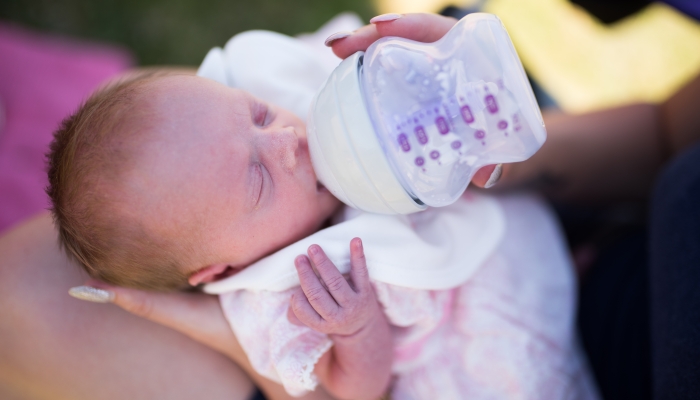
Feeding and Eating, Special Needs
Feeding Therapy Approaches for Infants with Special Needs
Many children with special needs have feeding difficulties. Working with a speech therapist, being patient, and experimenting with textures can help.
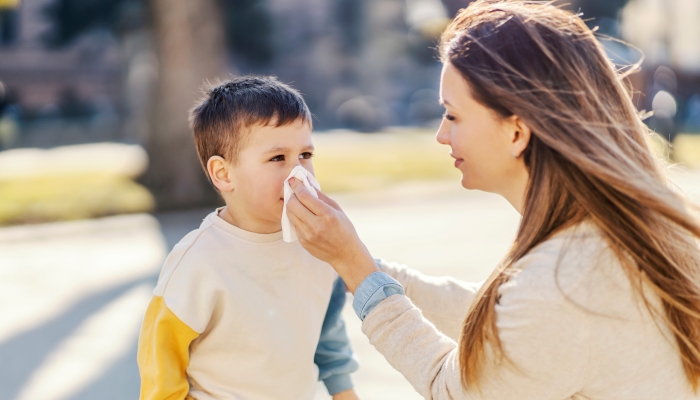
5 Tips for Managing Spring Allergies in Kids
Spring allergies can cause uncomfortable symptoms. The best way to navigate allergies in kids is to identify triggers and avoid exposure.

Your Child’s First Visit
For patients (in this section).
- Can Your Child Be Seen?
- Your Child’s First Visit
- School-Based Dental Care
- Hospital Services
- Parents & Guardians
- Teacher Resources
- School-Based Programs & FAQs
- Classroom Resources
- Brite Knight
- What Happens at a Dental Visit
- Kids With Special Needs
- Resources for Parents & Kids
- For Providers
- Referring to OHP
- Why Support OHP
- Ways to Give
- Join Us/Careers
- Our Mission
- Team Member Portal
My child is just getting their first baby tooth, should I visit the dentist?

Your baby’s first dental visit should be after the first tooth appears, yet before their first birthday. It might seem early, but you want to get your child’s oral health off to a healthy start!
Here are a couple of tips to get you ready for your child’s first visit:
- Talk to your child about the dentist and dental visit, be sure to be positive about this new adventure!
- Have your child practice opening their mouth, and counting their teeth.
- Read a book or watch videos about the first trips to the dentist.
- Fill out the health forms ahead of time (you can fill out OHP’s forms right here! )
- Make a list of questions for the dentist or dental advice they can offer.
During the visit, the dentist will examine your child’s teeth and jaw to make sure everything is developing correctly. After the exam, your child’s teeth will be cleaned and you will get tips for tooth care and have any questions answered.
Don’t worry if your child gets the wiggles, or cries during their visit. We see lots of kids and we know this is a new experience for your child!
Keep in mind some tips for a great first visit:
- Don’t schedule during naptime.
- Make sure your child isn’t hungry during the visit, but save snack time until after the visit so your child’s teeth are clean and ready to be examined.
- Brush your child’s teeth before your visit.
- Stay positive!
- Use their first dental visit as an opportunity for them to learn about good tooth health and how to start habits that will keep their smile healthy for years to come!
My child is a little bit older and getting ready for their first visit, what should I expect?
We are so excited to see you for your child’s first visit! Many of the same tips apply whether your child is a baby or a little older. If your child is a little older, some differences might be going into the exam area by themselves. This helps establish trust between the dentist, hygienists and the patient.
Your child might get x-rays on their visit. These will help the dentists see if any issues can’t be seen when they look in your child’s mouth. They will also show how the jaw and the bones are developing.
If your child is having pain be sure and mention that when making the appointment. This will help the dentist during the exam so they can diagnose the problem.
If you have any questions or concerns about your child’s first visit, be sure and ask when you are making the appointment. We are always excited to meet new patients and help them get and keep healthy smiles!

wilsonpediatric
Wilson Pediatric Dentistry
Read our statement with important information about health and safety here »
How to Prepare Your Baby for Her First Dental Visit
As a new parent, you have so many doctor appointments and check-ups to remember that scheduling your baby’s first dental visit might be the furthest thing from your mind. So when should you take your baby to the dentist for the first time? Continue reading to learn more.
Your Baby’s First Dentist Appointment
When to schedule.
The moment your baby’s first tooth breaks the surface of her gums, she is susceptible to cavities and tooth decay. That’s why the general rule of thumb is that a baby’s first dentist appointment should be after her first tooth appears but no later than her first birthday.
Establishing dental hygiene habits early is the best way to avoid complications and cavities later in her life. This first appointment will serve as an opportunity to get the baby used to the idea of going to the dentist as well as offering a chance to share valuable information with you regarding oral health in her first years of life.
Things We’ll Discuss
Some of the things we’ll discuss in your baby’s first appointment will include topics such as healthy habits and diet. We’ll help guide you in teaching her how to brush her gums, even if her first teeth haven’t erupted yet. We will also talk about how giving her a bottle at night can lead to early tooth decay and other dietary subjects.
This is the perfect opportunity to bring questions about subjects such as teething, thumb sucking, and pacifiers. Subjects like these can feel overwhelming and we want to help you feel as informed and prepared as possible.
How to Prepare for Her First Visit
The best way to help your baby feel as comfortable as possible during her appointment is to eliminate the element of surprise. Explain who a dentist is and what she can expect when she arrives. Help her to practice opening and closing her mouth so she won’t be thrown off guard during her appointment.
Look for books or videos that can help explain her first visit to the dentist. Overall, let her see that you are excited and ready for the appointment, and she will follow your lead.
Schedule an Appointment in Greenville, NC
It’s not too early to schedule your baby’s first appointment at Wilson Pediatric Dentistry. Our team specializes in providing excellent oral health care while making our younger patients feel as comfortable as possible. Give us a call or schedule your appointment today.
tel: +1 252.291.4300 [email protected]
Wilson Pediatric Dentistry 2401 Wooten Blvd SW Suite F Wilson, NC 27893
From the Blog
- Do Routine Teeth Cleans Matter? Yes — Here’s Why
- Preventing Cavities in Greenville, NC: A Parent’s Guide to Oral Health Habits
- The ABCs of Dental Fillings: Understanding the Process
- Dental Cleaning & Exams
- Dental Sealants
- Dental Treatments
- Dentist Tips
- Emergency Dental
- Pediatric Dentist
Call Now: 252-291-4300
- Skip to main content
- Skip to header right navigation
- Skip to after header navigation
- Skip to site footer

Ask the Dentist
Health Begins in the Mouth | Dr. Mark Burhenne
Every product I recommend meets my rigorous safety and testing standards. When you buy through links on my website, I may earn a small commission which helps offset the costs of running this website. Learn more →
When Should My Child First See the Dentist?
Get Dr. B’s Dental Health Tips
Search the functional dentist locator, how to prepare for your child’s first dentist appointment, how long will the appointment last.
One of the most common questions I get from parents is “When should I bring my child in for his/her first dentist visit?”
Some parents want to wait a few years until their child has all his or her teeth; some want to bring in their infants just a few months after they are born; and others wait until their child is fully insured, which, depending on enrollment timing, can delay the first visit.
My Recommendation for Making a Child’s First Dentist Appointment
I typically tell my patients to bring their child in for his visit around the age of six months (which is usually when the first baby tooth appears in the mouth), or at least before his first birthday—whichever comes first. Tooth decay can happen to anyone, even infants, so it’s important to begin caring for your child’s teeth as soon as they start to come in.
It’s also essential to instill good dental hygiene habits in your child as early as possible because children who have had positive experiences with their dentists are more likely to love brushing and better care for their adult teeth. They are less likely to skip dental appointments and they are more likely to prevent the development of cavities .
First acclimating your child to the dentist office between the ages of six months and one year is a great way to start raising a health-savvy child , as is setting a positive example yourself. I encourage both parents to attend dental appointments with their child, if possible, so that he can see that proper oral health care is a family affair.
[callout-quiz banner=”Find a Functional Dentist” button_link=”https://askthedentist.com/directory” button_text=”Search Your Area”]
Free weekly dental health advice in your inbox, plus 10 Insider Secrets to Dental Care as a free download when you sign up

Our database of functional providers includes dentists, hygienists, and myofunctional therapists, in over 50 areas around the world and growing.[/callout-quiz]
Before your take your child to his or her very first dental appointment, there are a few things I recommend to help you both prepare:
- Help your child get excited about his visit. He may be too young to speak or understand languages, but he can pick up on tone and body language. If you appear happy and excited about visiting the dentist, he will be as well.
- Prepare for the possible reactions from your child by bringing a few comforting toys to help your child feel more at ease.
- Speak with your dentist ahead of time and have him or her explain what will happen during the first visit. Every dentist has a slightly different approach, and you’ll feel more prepared and relaxed after you know exactly what will occur.
What Happens During a Child’s First Dentist Appointment?
While all dentists have their own ways of handling infant patients, the first dentist visit is usually about the same no matter where you go. Since so few teeth have come in, the dentist can’t do much cleaning, but he or she will want to look at your child’s mouth to be sure everything looks healthy.
You will be able to stay with your child throughout the entire visit, and your role during this first appointment is key. You are your child’s familiar face, so it is important that you remain calm and collected. Your infant might scream or refuse to sit still, but that’s okay. In fact, most dentists expect that. Just work with your dentist to secure your child and make the appointment as positive as possible.
An infant dental appointment will usually include the following:
- Your dentist will examine your child’s teeth, gums, jaw, oral tissues, and bite to ensure everything is properly forming and coming into place.
- He or she will then carefully polish your child’s tooth or teeth, getting rid of any plaque along the gums.
- The dentist will take x-rays if any deep cavities are present and visible to the naked eye.
- Finally, he or she will advise you on home cleaning tips and techniques.
Most infant dental appointments are brief—typically 15-30 minutes long—for good reason. Because dentists can be intimidating to infants and young children, short visits leave little time for children to get scared. This ensures that the child will develop trust with the dentist and also begin to understand that each appointment has both a beginning and, thankfully, an ending.
Children, like adults, should see a dentist every six months, but some parents like to bring them in every three months to help their children further establish rapport with his dentist. If a child is too fussy or inconsolable on the first visit, it’s okay. You can reschedule and try again in another two to three months.
The important thing to remember, though, is to not give up. Your child’s oral health begins with you behavior and attitude about your own dental visits. In the beginning, it’s you—not the dentist—who will be the best role model.
Dr. Mark Burhenne DDS
Got more questions about your child’s first dentist appointment? Ask me a question !
About Mark Burhenne, DDS
I’m on a mission to empower people everywhere with the same evidence-based, easy-to-understand dental health advice that my patients get. You can read my story here. I have been a dentist in private practice for 35 years. I graduated from the Dugoni School of Dentistry in San Francisco, CA in 1987 and am a member of the American Academy of Dental Sleep Medicine (AADSM), Academy of General Dentistry (Chicago, IL), American Academy for Oral Systemic Health (AAOSH), and Dental Board of California.

Dr. Mark is the author of the best-selling book 8-Hour Sleep Paradox
What to Expect at Your Child's First Dental Visit

Your child’s first dental visit is an important and exciting milestone. In addition to monitoring your child’s oral health and development, regular pediatric dental care sets your kids up for a lifetime of healthy teeth and gums. It also helps your child form a good relationship with their dentist, which is one of the best ways to prevent dental anxiety and fear in the future.
At Oasis Pediatric Dental Care & Orthodontics, our pediatric dentist, Dr. Nathalie Phaeton , and our orthodontist, Dr. Ki Youn Kil , cover all of your child’s dental needs, including their first visit , at our office in Falls Church, Virginia.
What to expect at your child’s first dental visit
Every child develops at their own rate, but the first tooth usually erupts around the age of six months. The American Dental Association (ADA) and the American Academy of Pediatrics (AAP) generally advise that you schedule your child’s first dental visit by the age of one, or six months after the first tooth has erupted.
It might be hard to believe, but that first tooth and dental appointment will tell our dentists (and you) a lot about how your child’s oral health and development is progressing, what you can expect as their teeth continue to erupt, and how to care for their new teeth and adorable little gums. It’s also an opportunity for you to ask questions and share any concerns you may have with Dr. Phaeton and our team.
What’s included in your baby’s first dental appointment
Your child receives a full exam of their teeth and gums. It’s important to remember that even baby teeth are vulnerable to tooth decay, so this is the most important aspect of the appointment.
Our dentists also examine their jaw and bite pattern, and order X-rays, if necessary, so you know exactly what’s going on with your child’s oral health. We also give their teeth a gentle cleaning .
We go over the best way to clean and care for your baby’s teeth and gums at home , and discuss any issues or concerns around bottle feeding versus breastfeeding, thumb sucking, pacifier use, family history, and all of the factors that can affect your child’s oral health and dental development in the short- and long-term.
Finally, your child’s first dental visit is the start of their relationship with our office and dental team. We make sure that you and the little patient are comfortable and well taken care of so that your baby feels at home and won’t be afraid to come back for regular visits!
For more information about how to prepare for your child’s first dental visit, or if you have any questions about the dentistry services available at Oasis Pediatric Dental Care & Orthodontics, call us at 703-498-2440 today to schedule an appointment. You can also schedule online .
You Might Also Enjoy...

5 Unexpected Benefits of Dental Sealants

Bruxism in Children: What to Look for and How to Treat It

5 Easy Ways to Reduce Your Child's Cavity Risk

Your Child's Complete Guide to Good Oral Care with Braces

4 Ways to Start Taking Care of Your Baby's Oral Health

Sealants: Why Every Child Should get Them
825 Grand Avenue, New Haven CT 06511 Telephone: (203) 787-1176 Fax: (203) 787-0397

Baby's First Visit
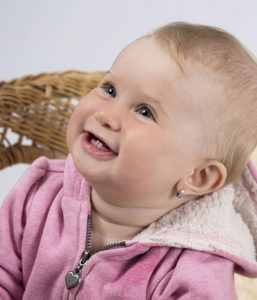
The purpose of your baby’s first visit is primarily to examine your child’s mouth and to check development. However, this visit is also intended to make your child comfortable with the idea of visiting the dentist.
Expect Dr. Kristi to:
- Inspect for oral injuries, cavities or other problems.
- Let you know if your child is at risk of developing tooth decay.
- Clean your child’s teeth and provide tips for daily care.
- Discuss teething, pacifier use, or thumbsucking habits.
- Discuss treatment, if needed, and schedule the next check-up.
To make the first visit a positive experience:
- Try to schedule a morning appointment. Children are often more rested and cooperative in the morning.
- Emphasize the positive aspects of the visit. It is meant to help. Keep any anxieties you might have to yourself; your child can be affected by your concerns.
- Explain how visiting the dentist and paying attention to proper dental care helps overall health and appearance.
- Never use a dental visit as punishment or as a threat, and never bribe your child with skipping a dental exam.

What Happens At Your Baby’s First Dental Visit?
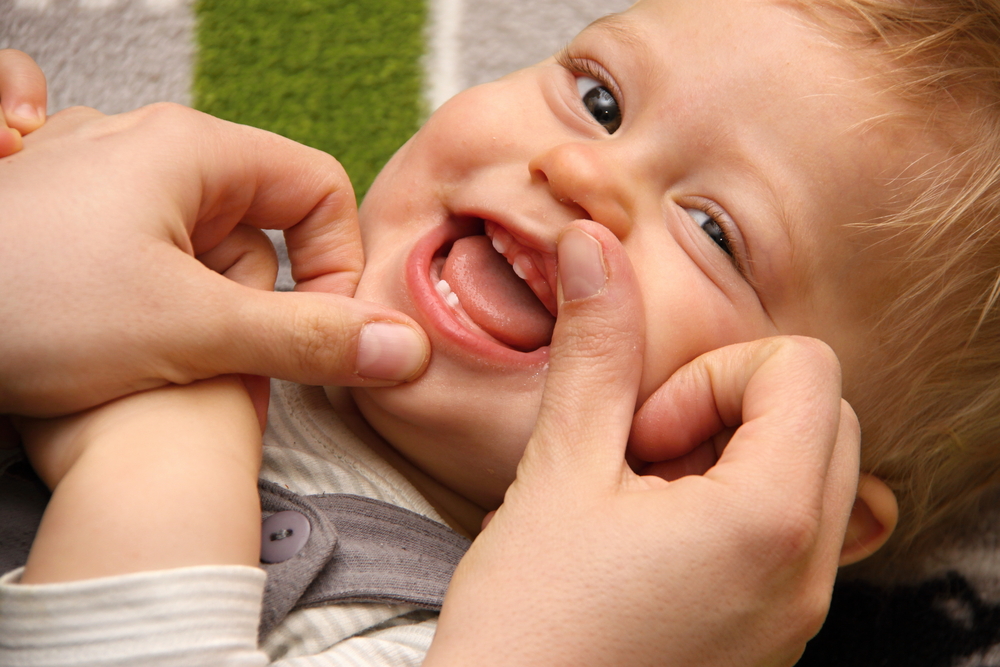
Previous Post Canker Sores in Kids: Causes, Symptoms and Treatments
Next post 10 tips on how to overcome your child's fear of the dentist.
Author Bitesize
Comments are closed.
Quick Links
F i r s t V i s i t
T r e a t m e n t s
A p p r o a c h
L o c a t i o n s
R e v i e w s
- Williamsburg Office
568 Union Ave Suite J Brooklyn, NY 11211, US
718-899-4500
- Park Slope Office
379 5th Ave Brooklyn, NY 11215, US
917-397-1341
- DUMBO Office
67 Front St Brooklyn, NY, 11201, US
917-781-0347

© 2024 Bitesize Pediatric Dentistry. Accessibility Statement Privacy Policy | Designed By: Happy Hive
- google-plus
- First Visit
- Meet The Bitesize Gang
- Pediatric Cleanings & Exams
- Safe Sedation
- Appliances & Maintainers
- Silver Diamine Fluoride
- Book Online
- Park Slope: 917-397-1341
- Williamsburg: 718-899-4500
- Dumbo: 917-781-0347

IMAGES
VIDEO
COMMENTS
The first dental visit is recommended by 12 months of age, or within 6 months of the first tooth coming in. The first visit often lasts 30 to 45 minutes. Depending on your child's age, the visit may include a full exam of the teeth, jaws, bite, gums, and oral tissues to check growth and development. If needed, your child may also have a gentle ...
When to schedule baby's first dental visit. It might sound early, but aim to schedule your baby's first dentist appointment at a pediatric dentist (or one who's good with children) within 6 months of the time he sprouts a tooth or turns a year old, whichever comes first, according to the latest guidelines from the American Academy of Pediatrics (AAP) and the American Academy of Pediatric ...
You should take your child for a first visit to the dentist by age 1 or within six months after the first appearance of their first tooth, whichever comes first. Babies tend to sprout their first ...
The dentist will examine your child to make sure their jaw and teeth are developing in the way they should. During the visit, you will be seated in the dental chair with your child on your lap if your child isn't able to — or doesn't want to — sit in the chair alone. The dentist will check for mouth injuries, cavities or other issues.
Once you have an appointment scheduled, start preparing your child for the visit. Children learn best when they are having fun. You can practice giving their stuffed animal a checkup with a toy mirror. Your child can bring that same stuffed animal to the dental visit to get a check-up by the dentist. Read books to them.
6 months to 18 months. Babies, she says, are the simplest of the age groups to prepare. For the youngest among them, all that's really needed is to come and sit in the chair. However, as kids approach the 1-year mark and head toward their toddler years, there are a few tricks parents may want to employ. "They're very inquisitive at this ...
An examination in a 'knee-to-knee' position. In the knee-to-knee position, you and the dentist sit on chairs facing each other with your child sitting on your lap, facing you. You then lower the child's head onto the dentist's lap so you and dentist can see clearly into your child's mouth and your child can look up at you.
The dentist can provide or recommend preventative information regarding baby bottle tooth decay, infant feeding practices, mouth cleaning, teething, pacifier habits, and finger-sucking. habits. ... Your child's first dental visit is to help your child feel comfortable with the dentist. The first dental visit is recommended by 12 months of age ...
Step 3: Make the Dental Appointment Fun. Keeping a positive attitude and talking excitedly about the dental visit will go a long way in making your child feel comfortable instead of scared. However, if you sense your child is nervous, bring along a stuffed animal friend. The "friend" — or an older sibling — can go first, and the dental ...
Most American children see their family dentist for the first time well after their second birthday, far later than recommended by dental professionals. The American Academy of Pediatric Dentistry (AAPD) recommends that children visit the dentist for the first time by age 1, or within six months of the date their first tooth erupts.
Baby teeth usually start to appear between 4-7 months of age. The lower teeth usually come in first. Once your baby's teeth appear, it is time to start brushing them with a smear of fluoride toothpaste on an infant sized toothbrush. A smear of toothpaste is the size of a grain of rice. At 4 years old, your child's jaw and facial bones will ...
Both the American Academy of Pediatrics (AAP) and the American Academy of Pediatric Dentistry (AAPD) recommend that your kiddo be examined by a dentist soon after their first tooth erupts…or within six months of their first birthday. Unfortunately, studies show that the average age when children actually first visit the dentist is three years ...
Give them every opportunity to enjoy their first visit. Explain why it's important to go to the dentist and how it keeps them healthy. Take time to answer any questions they may have. Try to schedule a morning appointment when your child is likely to be more awake and attentive. The day of the visit, go over what to expect one more time.
Tips For Your Child's First Dental Visit. As soon as your child gets their first tooth, go ahead and schedule an appointment close to their first birthday. ... Preventive Care Can Lead To A Lifetime of Dental Health. Just like with a well-baby check at the doctor, bringing your child to the dentist at a very early age can help to establish ...
In fact, a baby's first dental appointment needs to happen before their first birthday or when their first tooth comes in. Your family or pediatric dentist will want to evaluate for things like: oral development. tongue ties. lip ties. And as teeth start coming in, they'll also screen for: baby bottle tooth decay. impacted teeth.
Abstract. The aim of the study was to test an information booklet containing suggestions to parents on how to prepare their child for the first dental visit. Forty-five children and one parent per included child took part in the trial. Children were randomized in two groups; the information booklet was e-mailed to the parents of the study group.
At your child's first dental visit, you can expect to be there for no more than 45 minutes. Their dentist will conduct a regular exam which includes checking your baby's teeth for tooth decay, pacifier teeth, gum condition, and bite. If they think it necessary, they may do a gentle cleaning and polish too. Unless there's an issue, you ...
Your baby's first dental visit should be after the first tooth appears, yet before their first birthday. It might seem early, but you want to get your child's oral health off to a healthy start! Here are a couple of tips to get you ready for your child's first visit:
The moment your baby's first tooth breaks the surface of her gums, she is susceptible to cavities and tooth decay. That's why the general rule of thumb is that a baby's first dentist appointment should be after her first tooth appears but no later than her first birthday. Establishing dental hygiene habits early is the best way to avoid ...
My Recommendation for Making a Child's First Dentist Appointment. I typically tell my patients to bring their child in for his visit around the age of six months (which is usually when the first baby tooth appears in the mouth), or at least before his first birthday—whichever comes first. Tooth decay can happen to anyone, even infants, so ...
What's included in your baby's first dental appointment . ... For more information about how to prepare for your child's first dental visit, or if you have any questions about the dentistry services available at Oasis Pediatric Dental Care & Orthodontics, call us at 703-498-2440 today to schedule an appointment. ...
The American Dental Association recommends that the first dental visit take place within six months after the first tooth appears, but no later than a child's first birthday. The purpose of your baby's first visit is primarily to examine your child's mouth and to check development. However, this visit is also intended to make your child ...
While we don't use a one-size-fits-all approach to the first appointment and we'll let your infant or toddler set the pace, in general, here is what happens at your baby's first dental visit: 1. Receive a Warm Welcome. At your child's first dental visit, or any visit, they'll receive a warm welcome from our friendly team members.